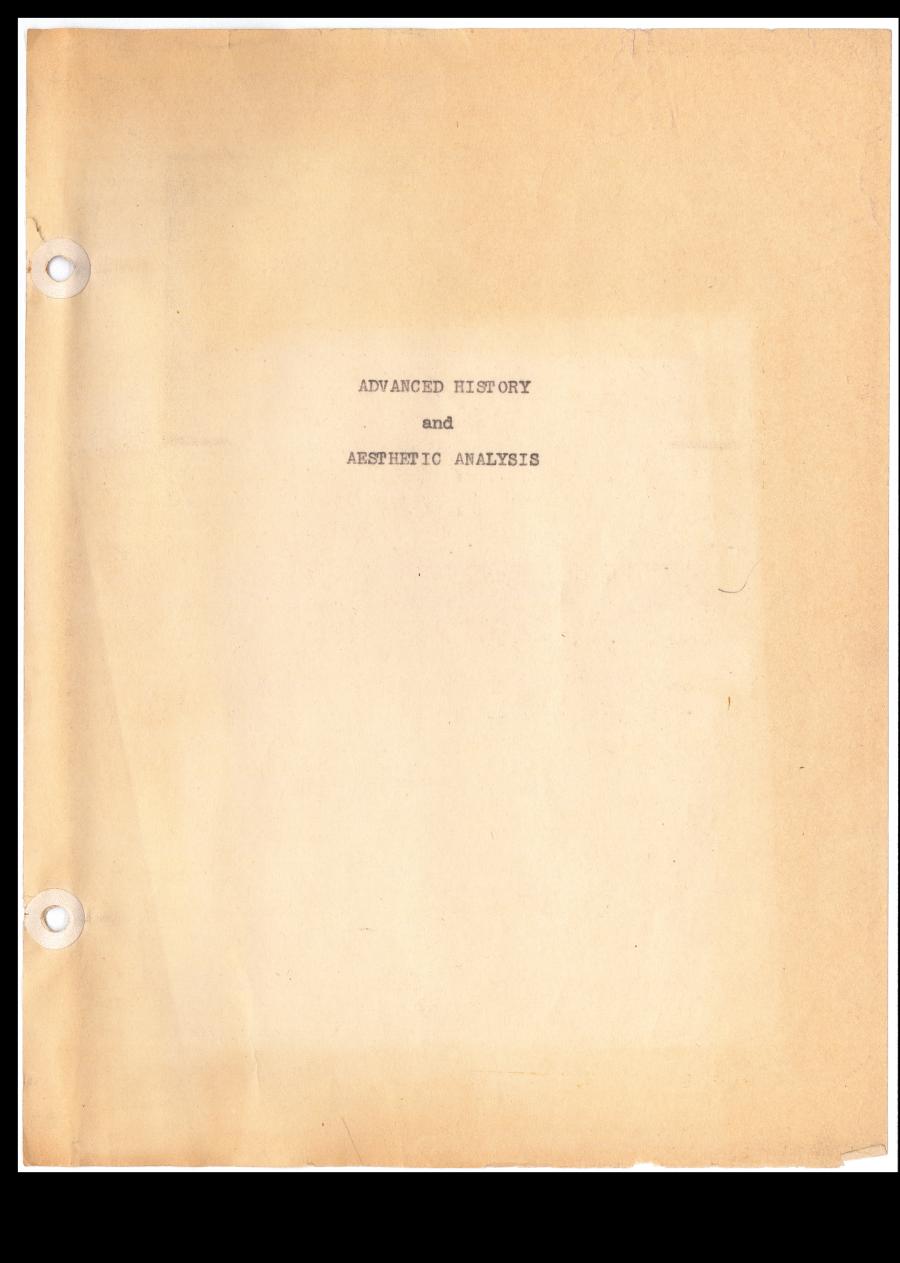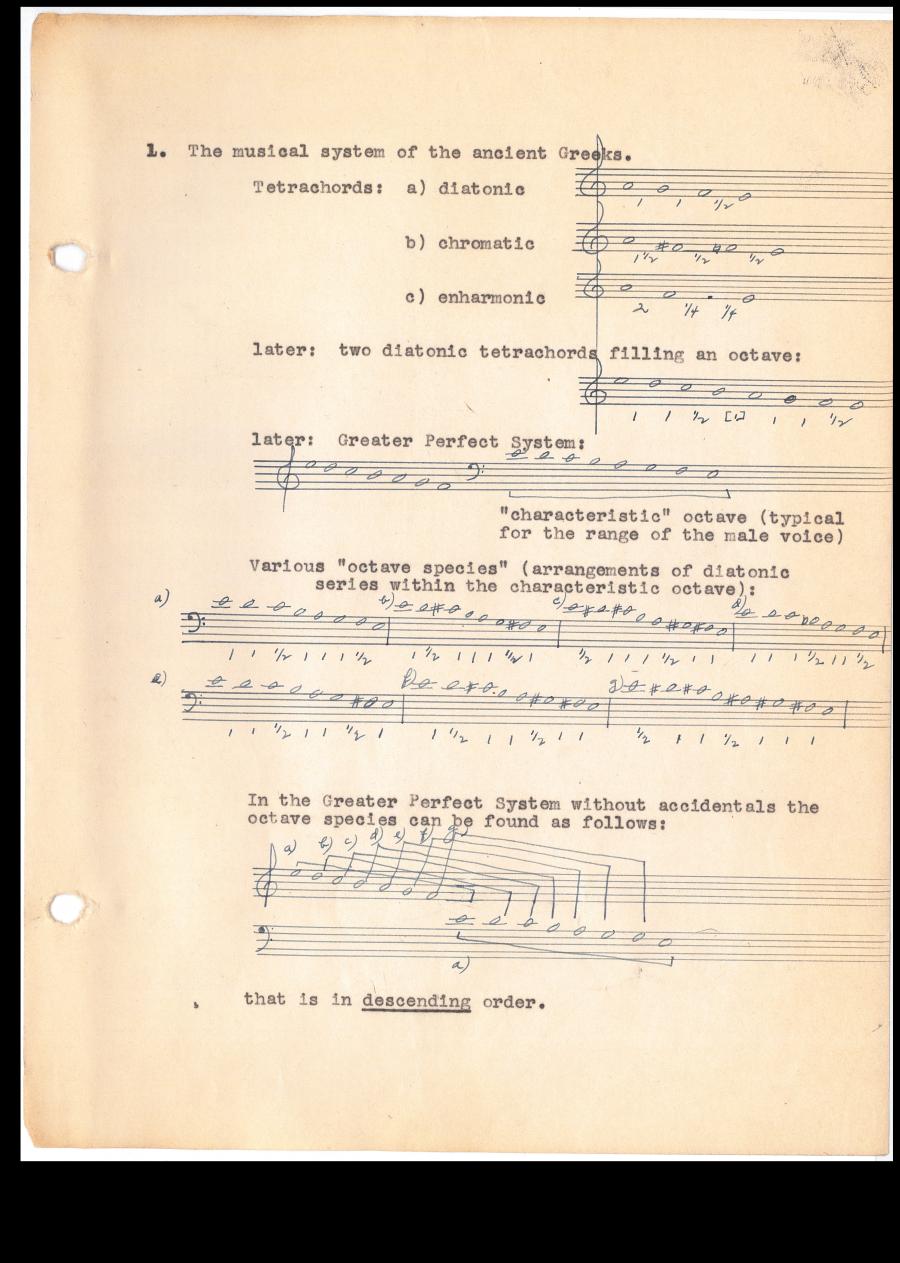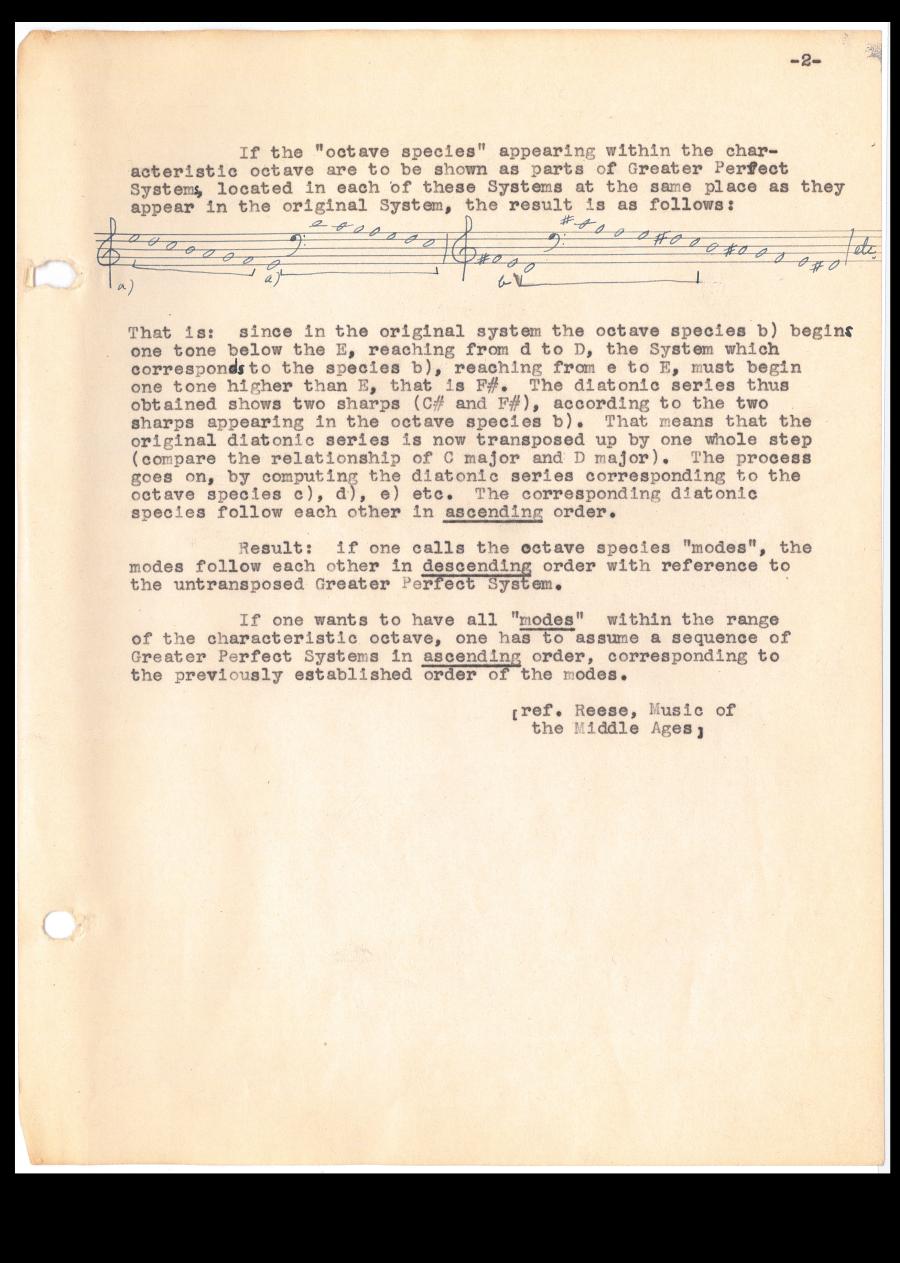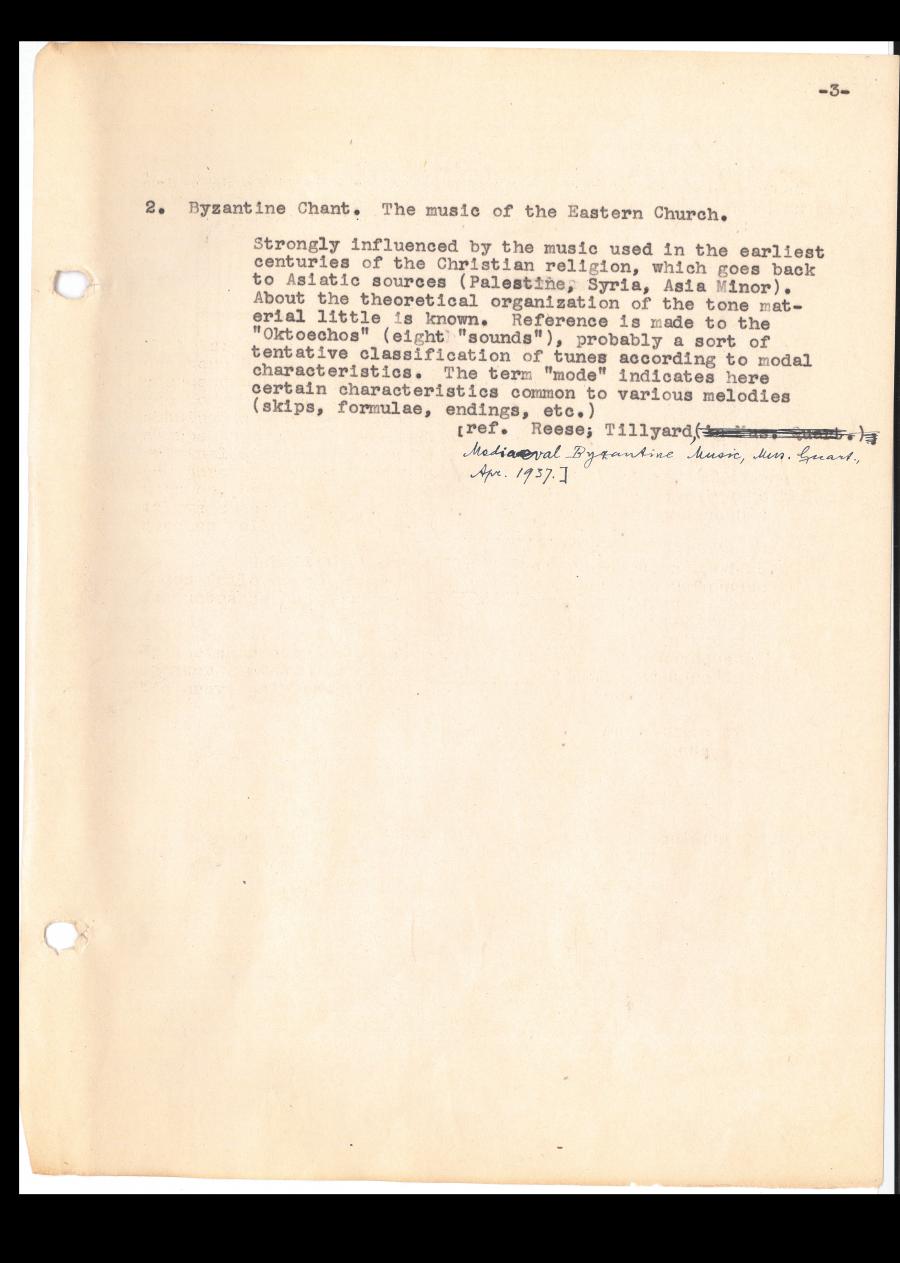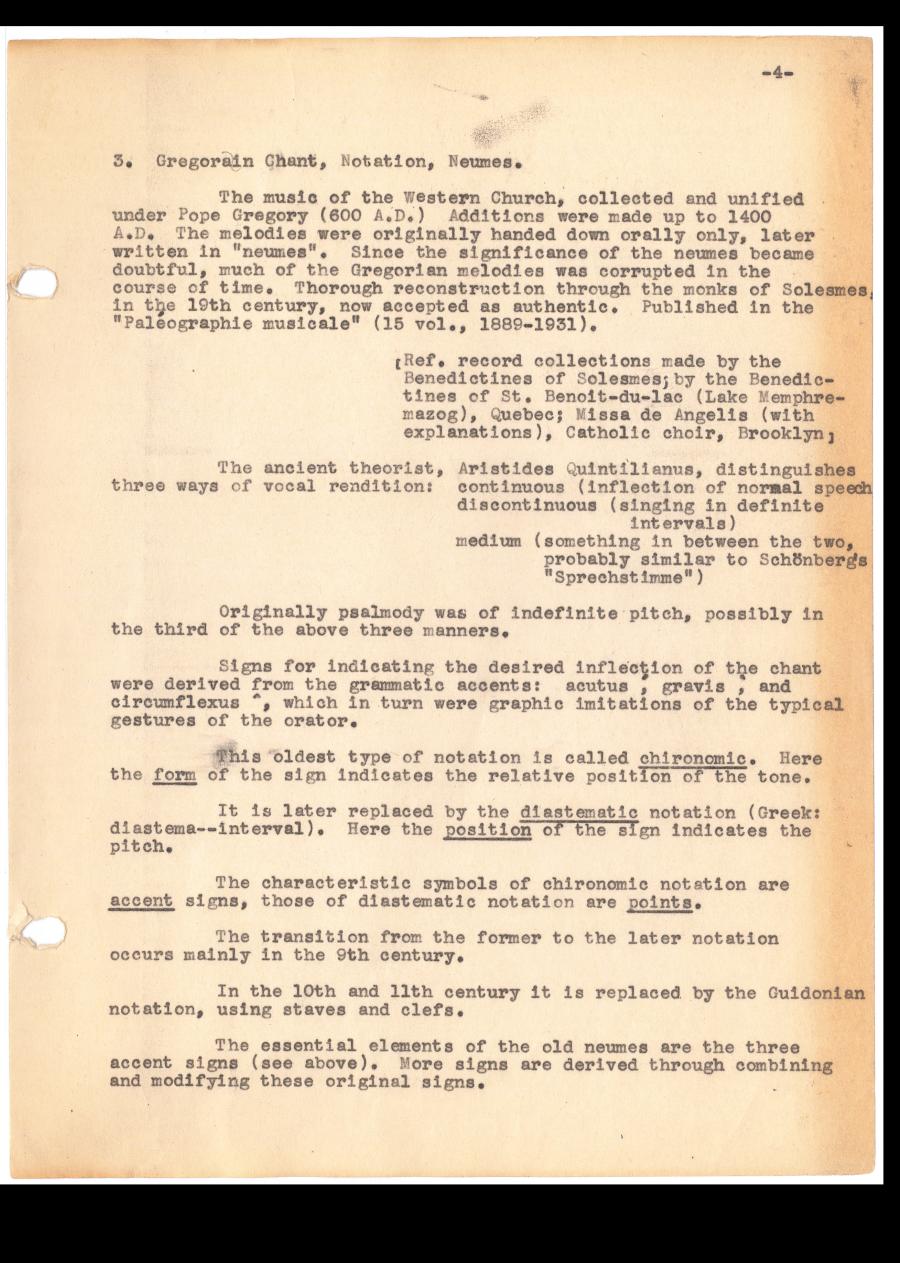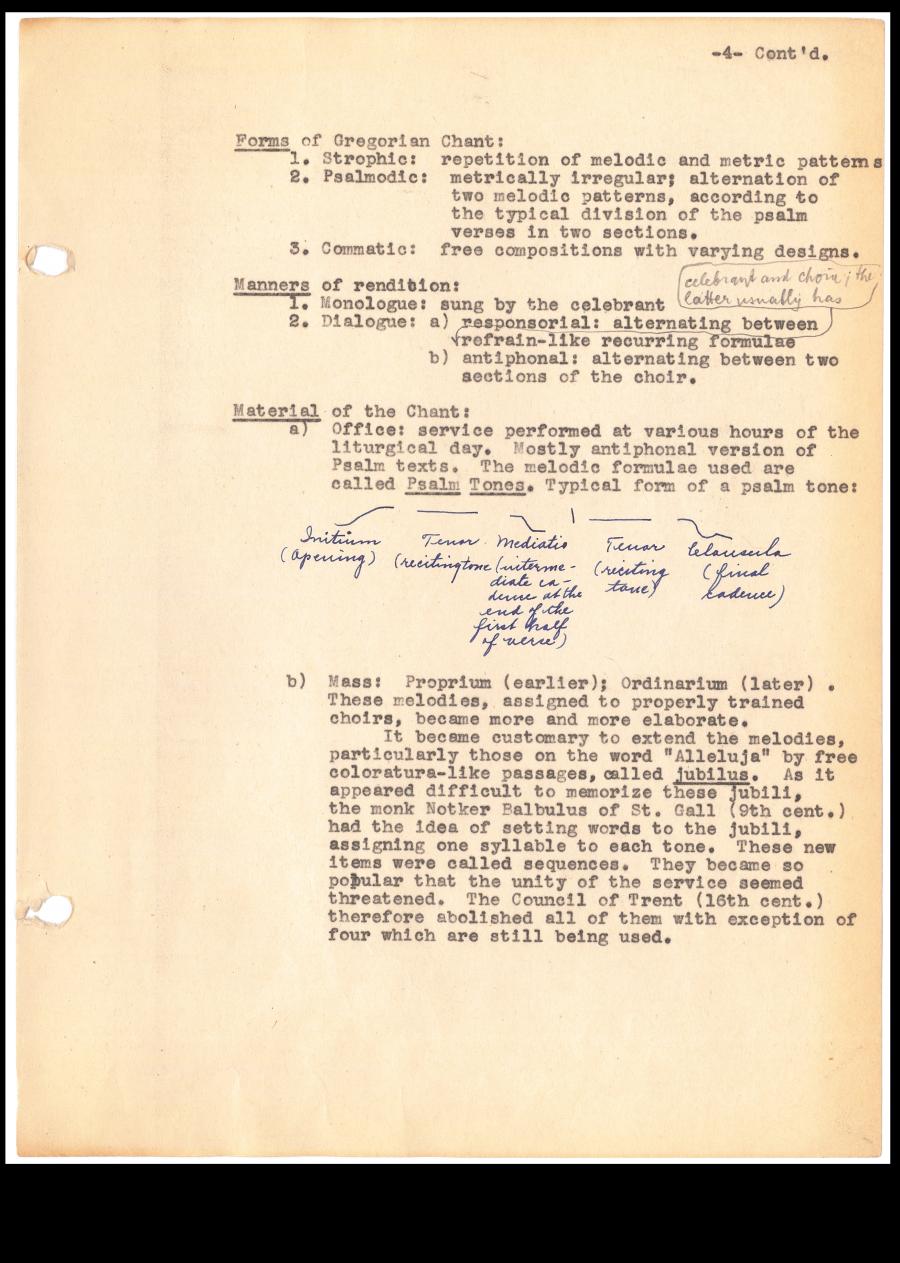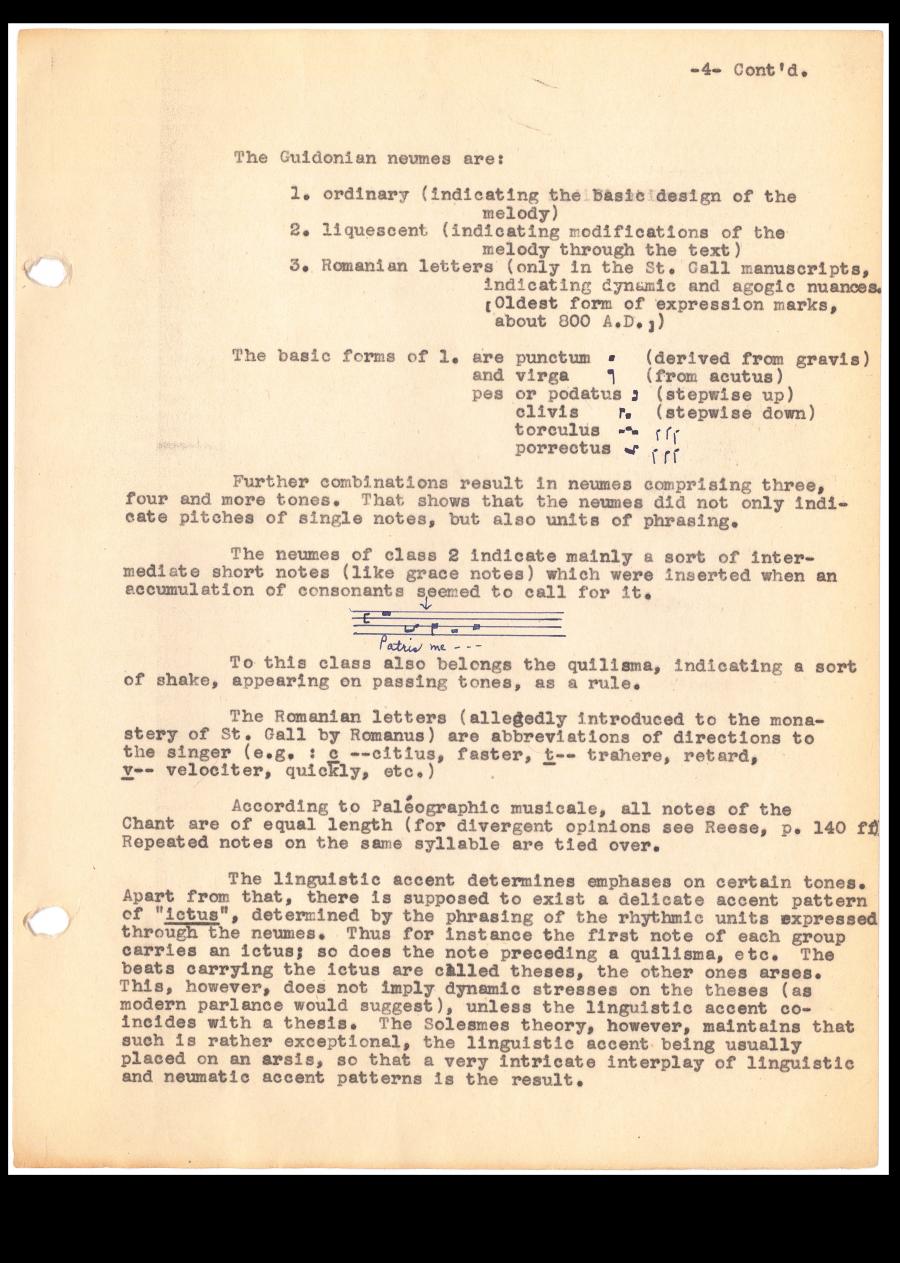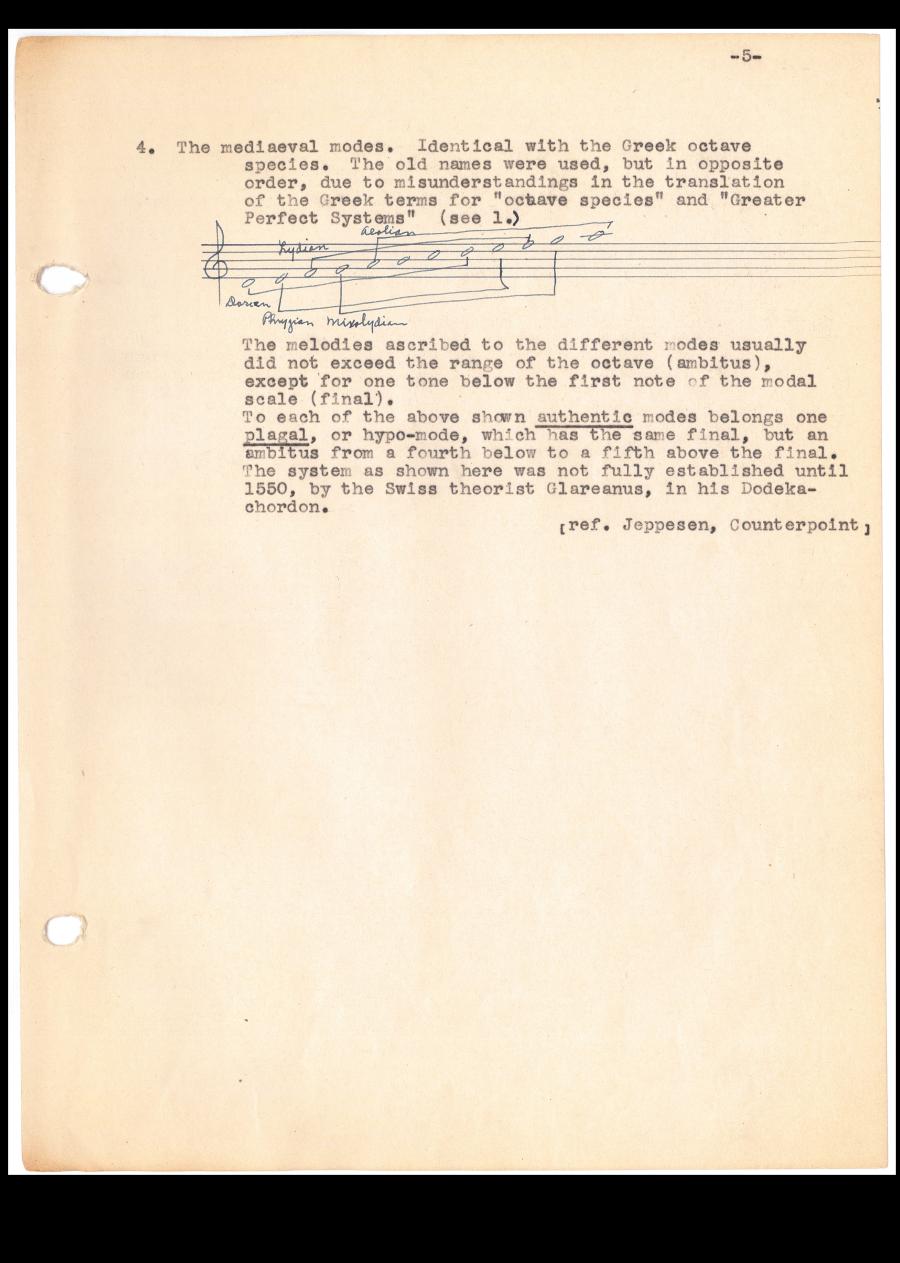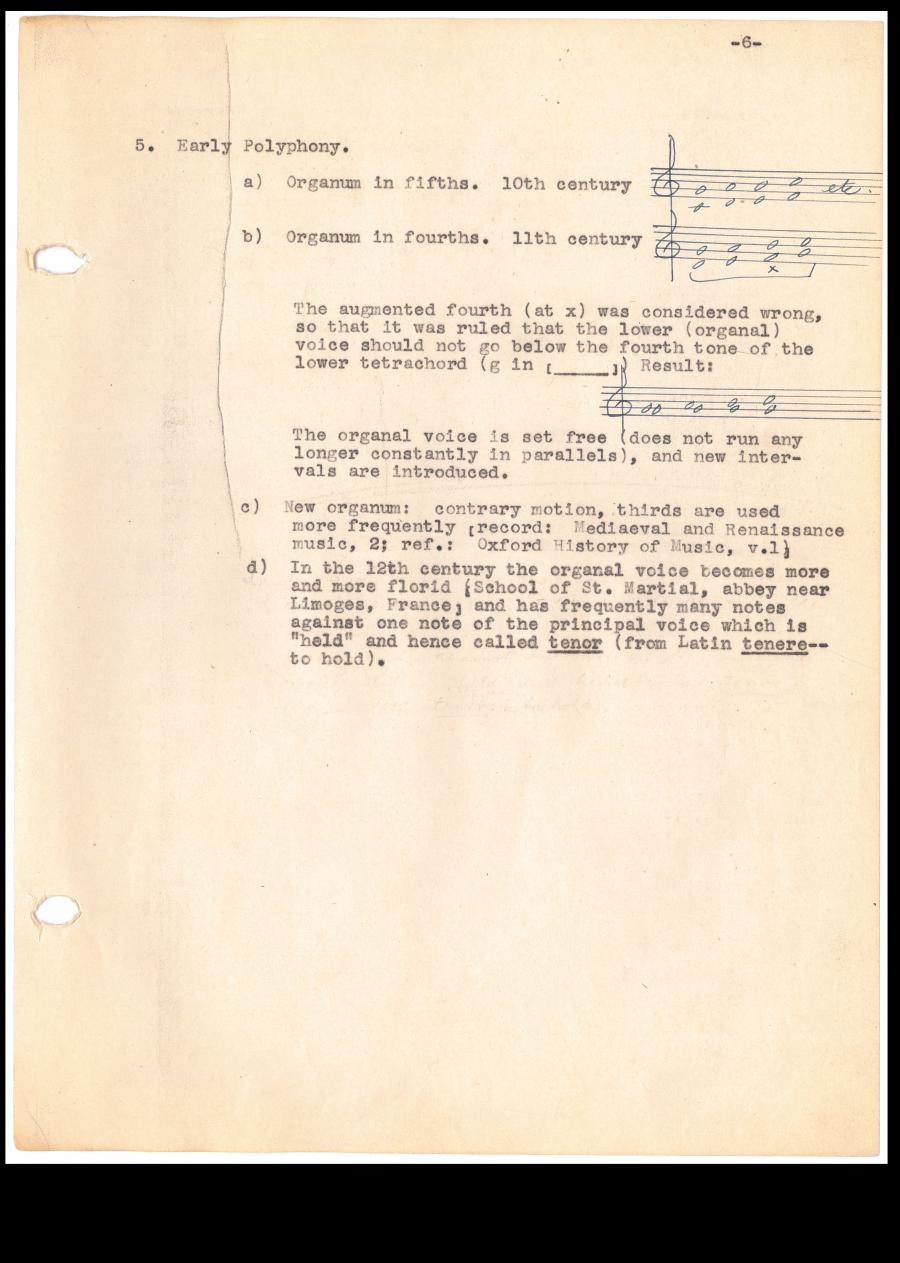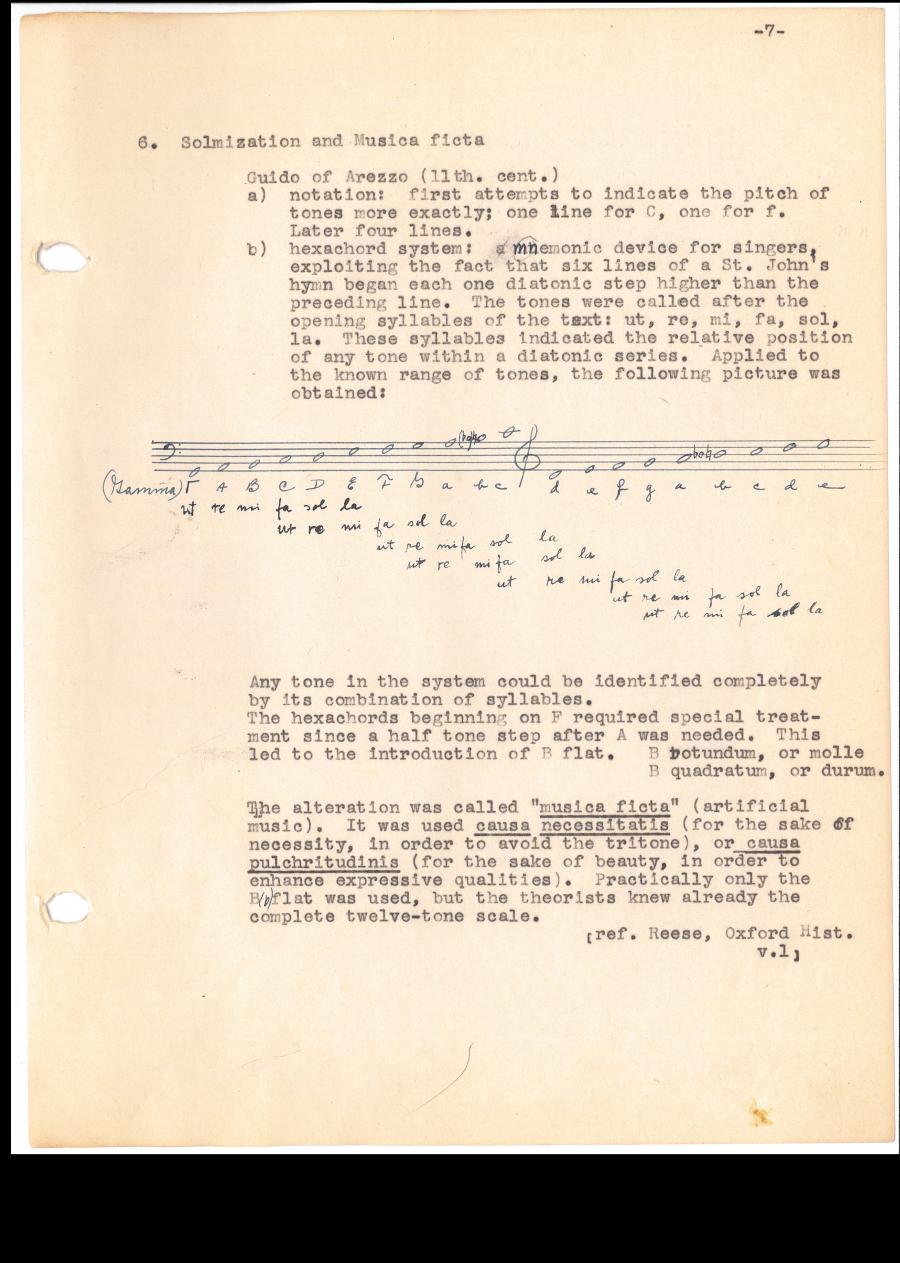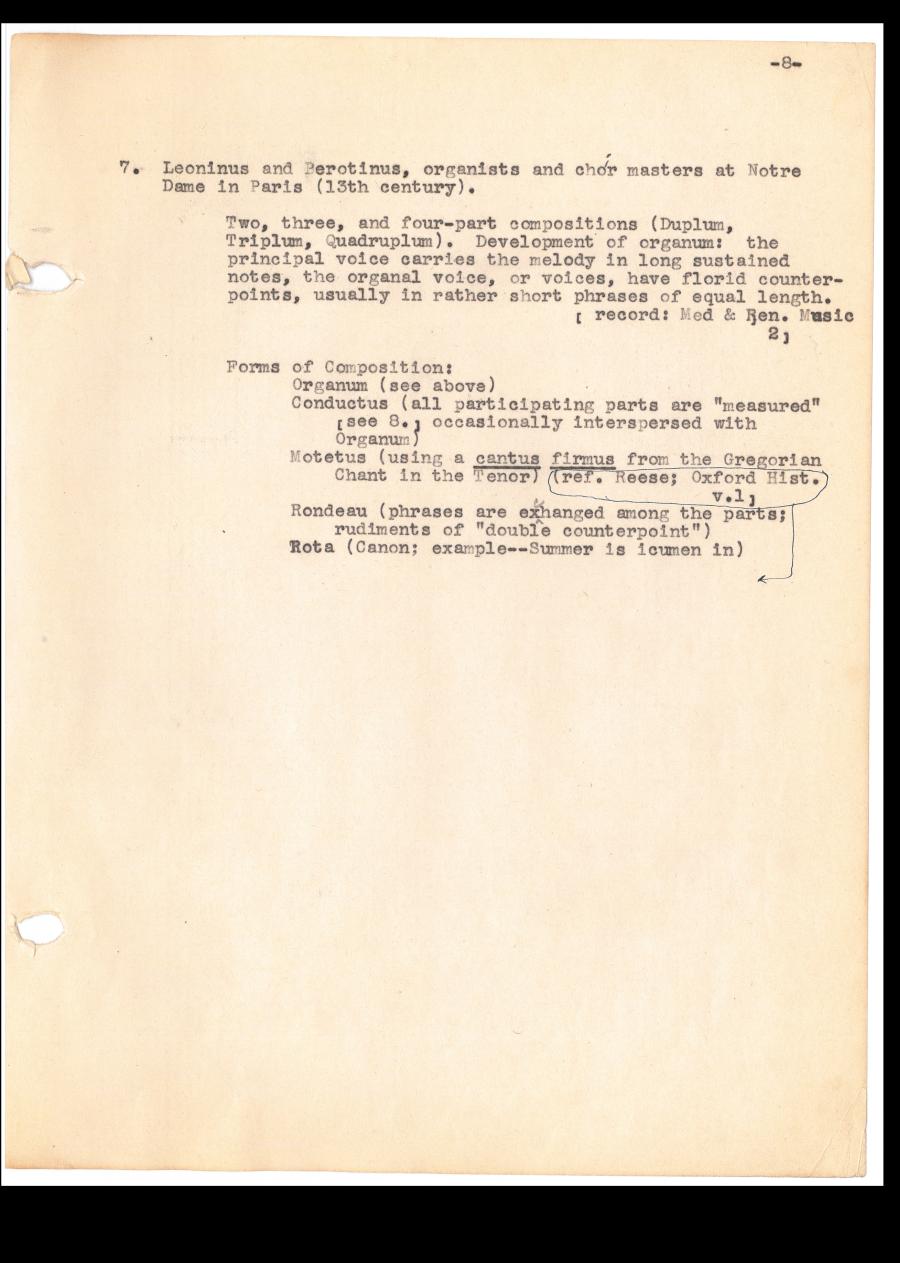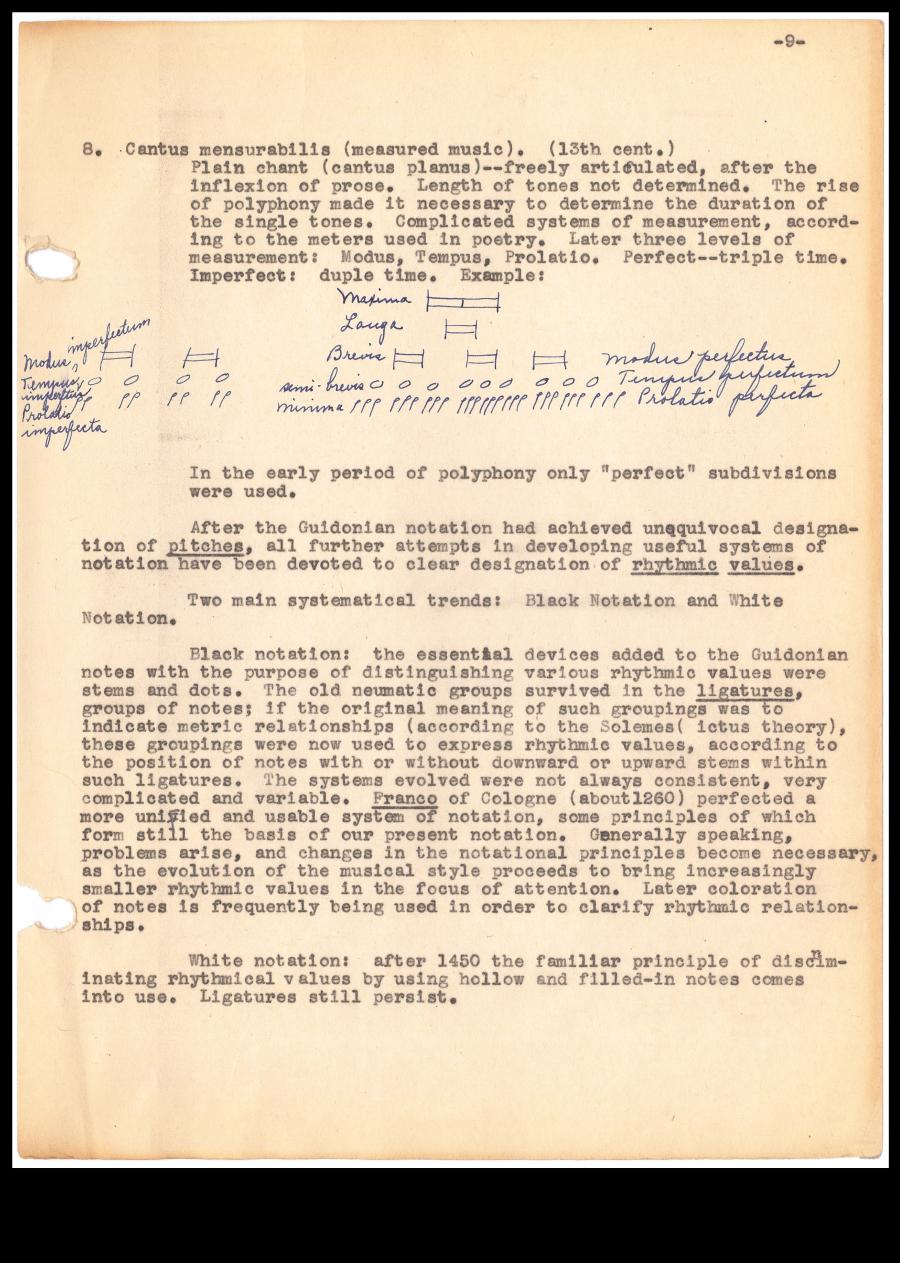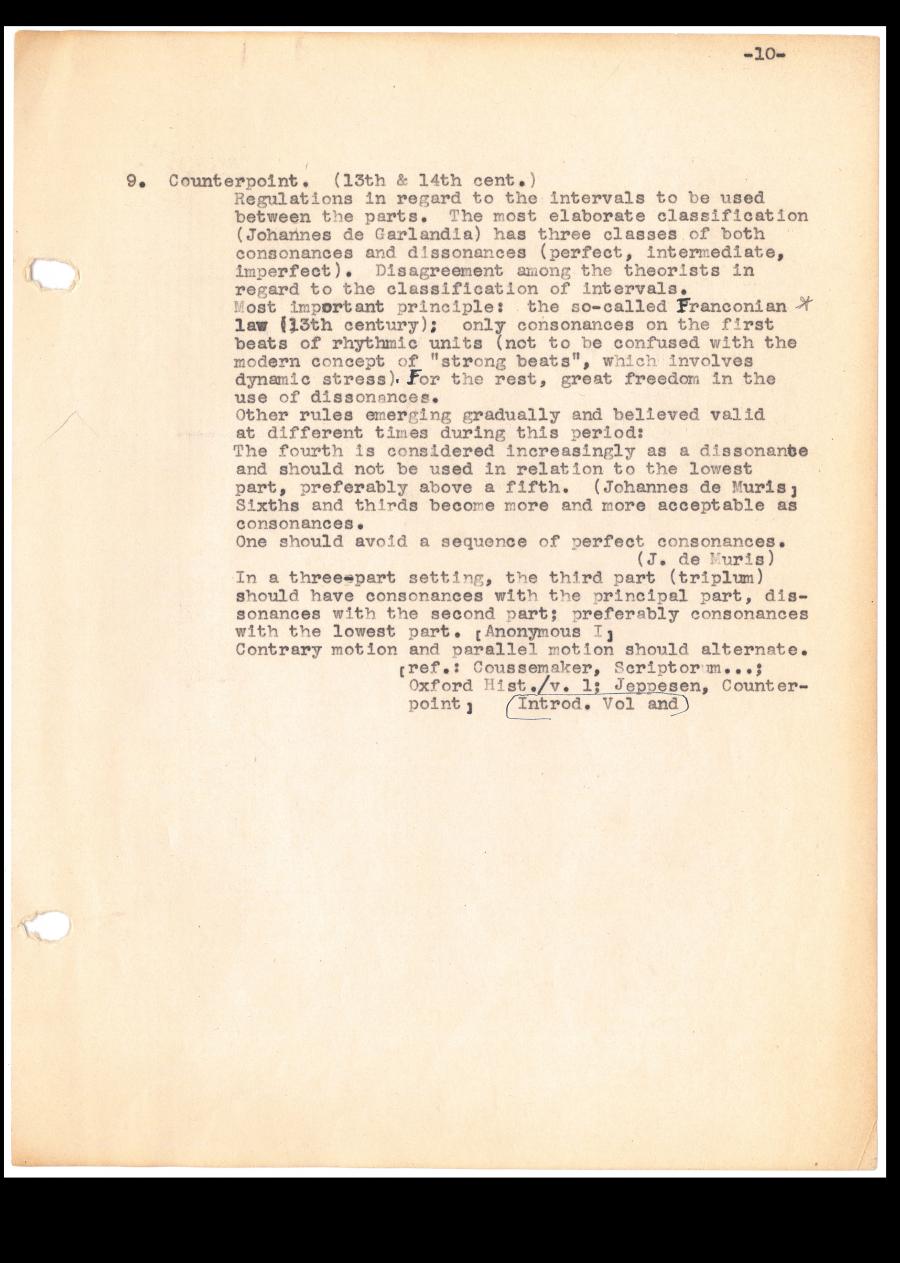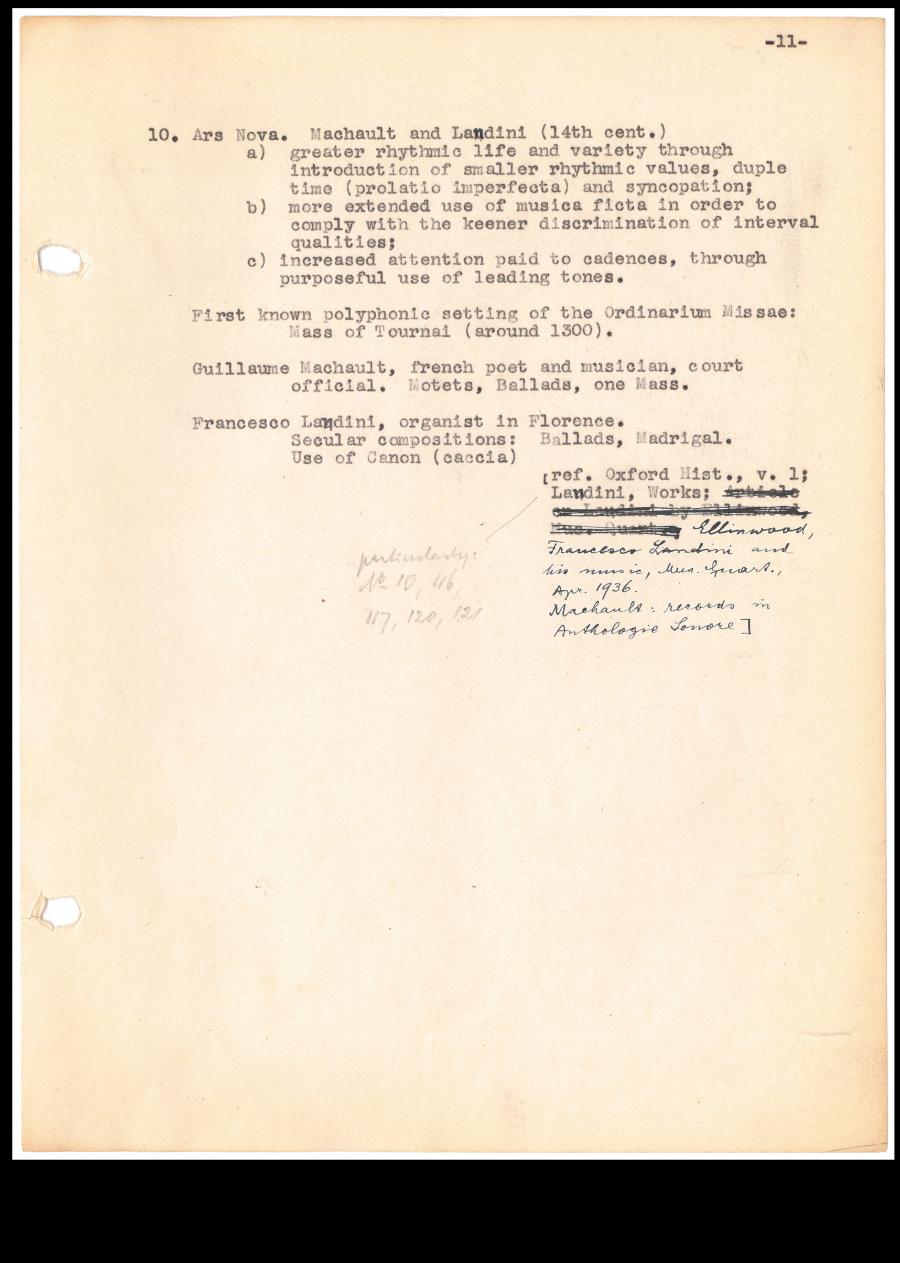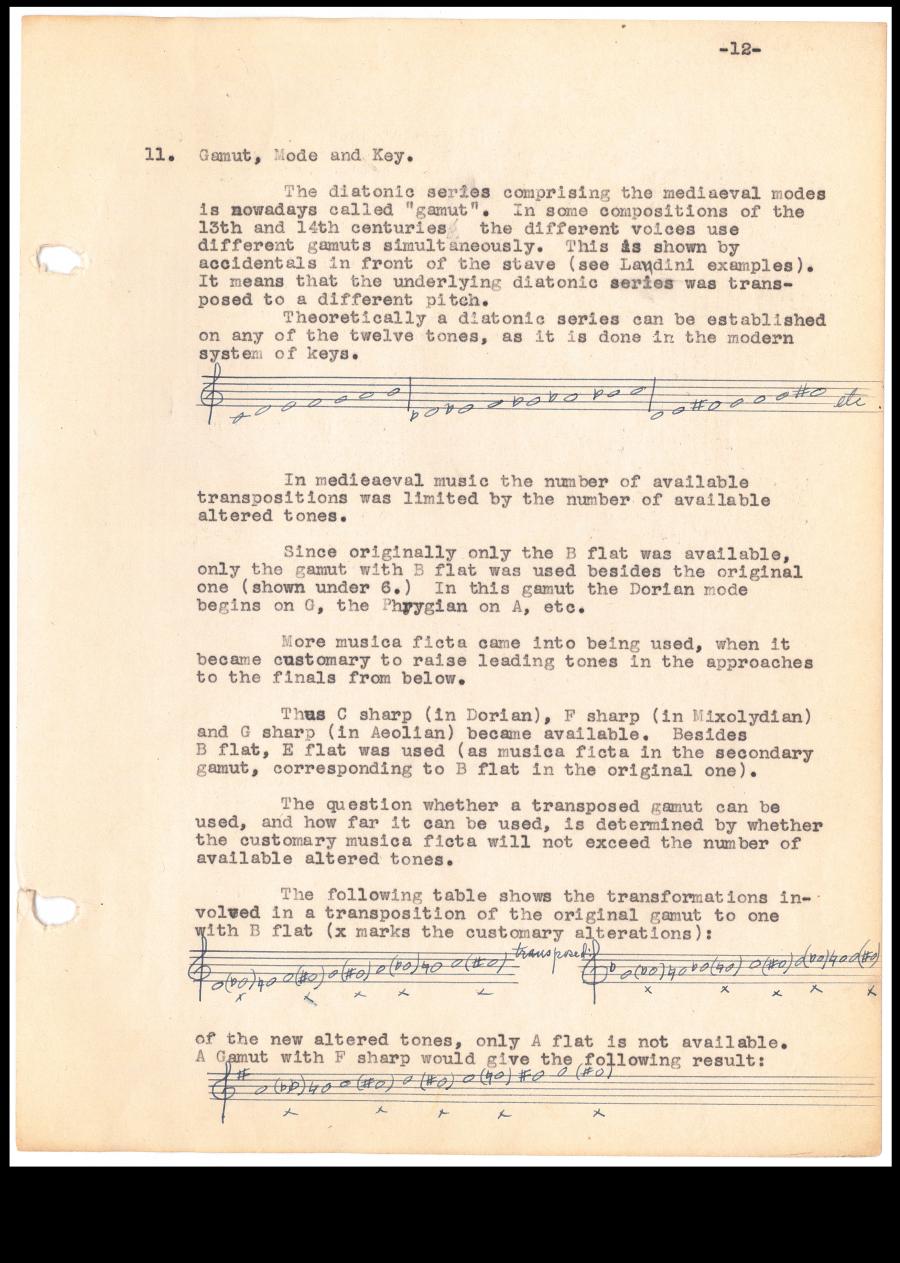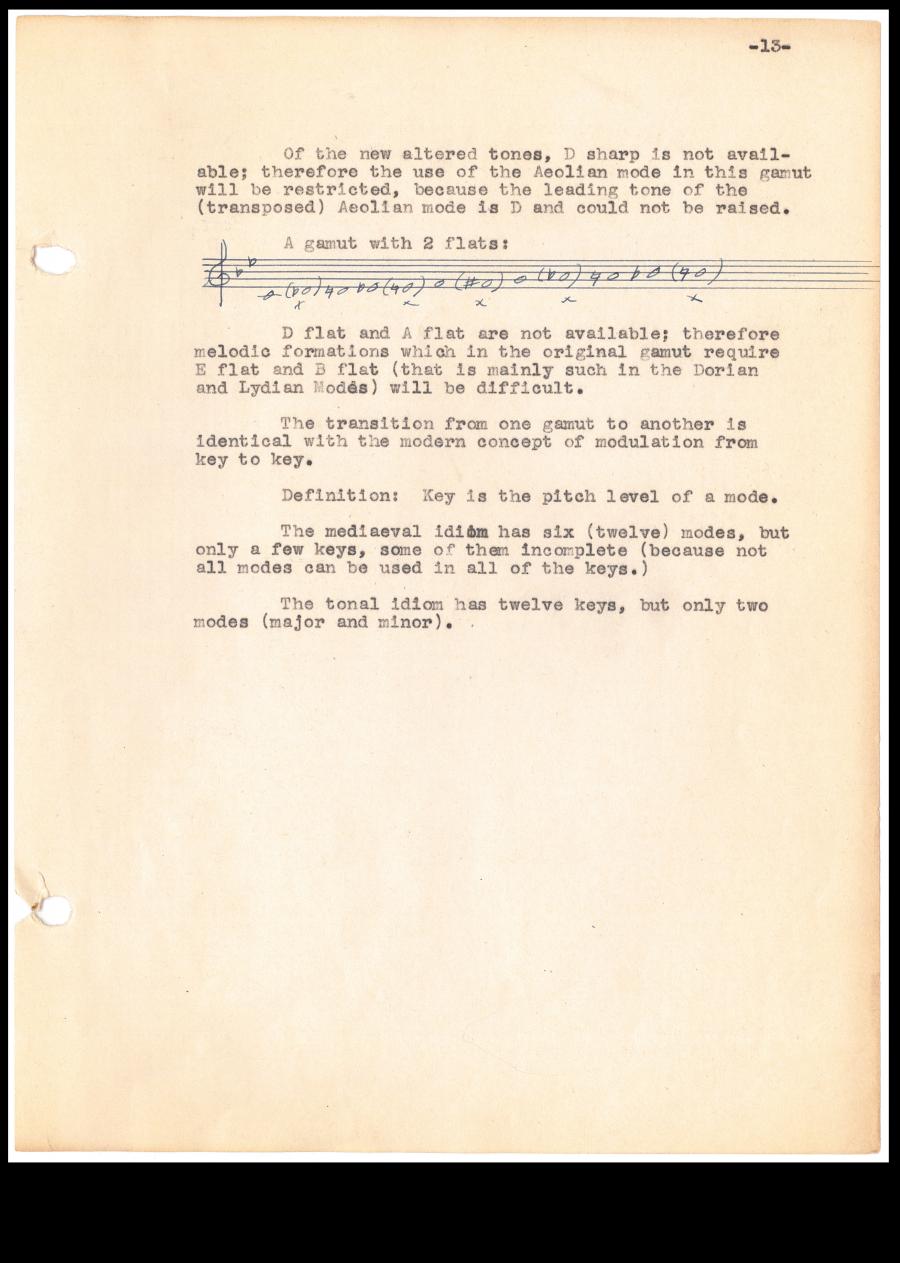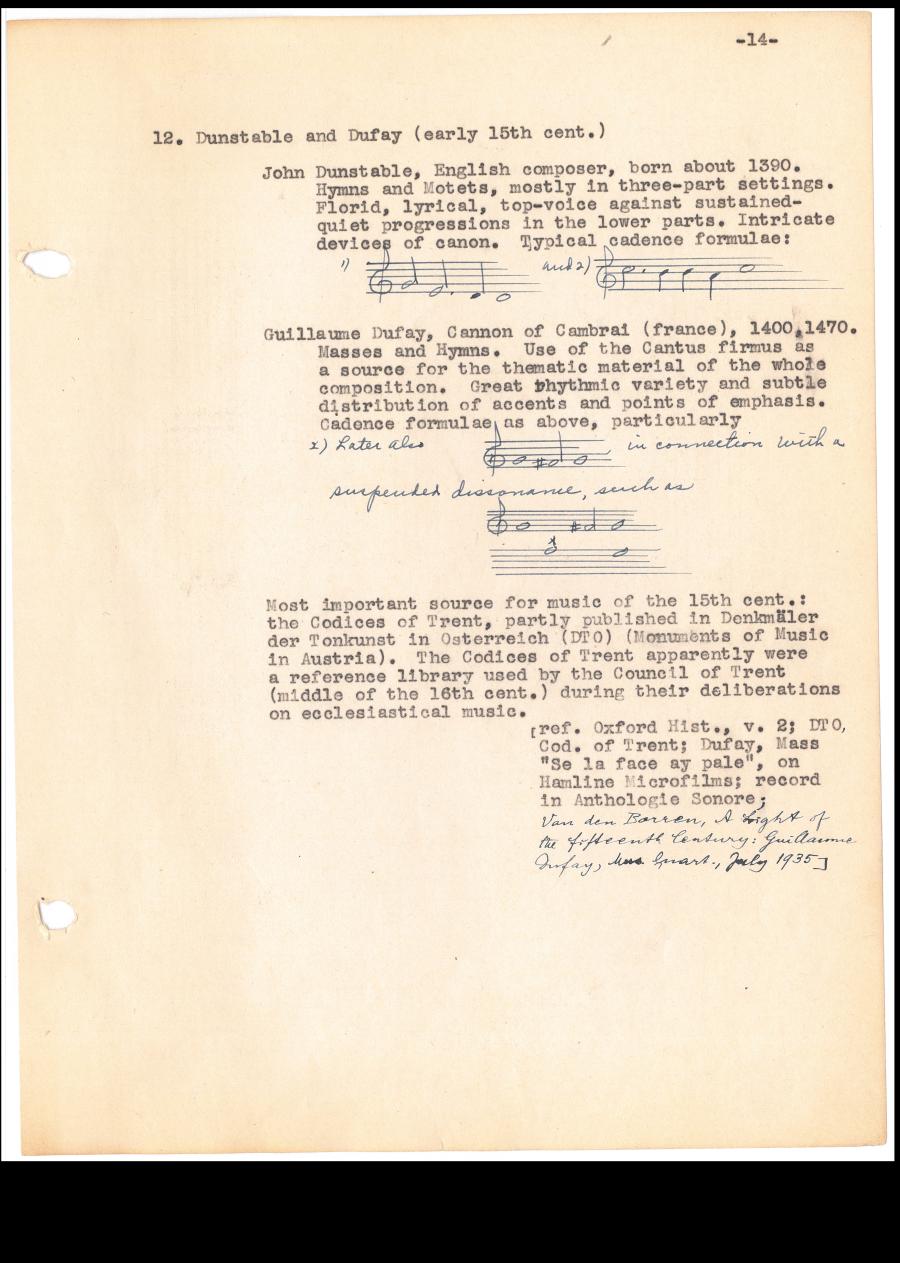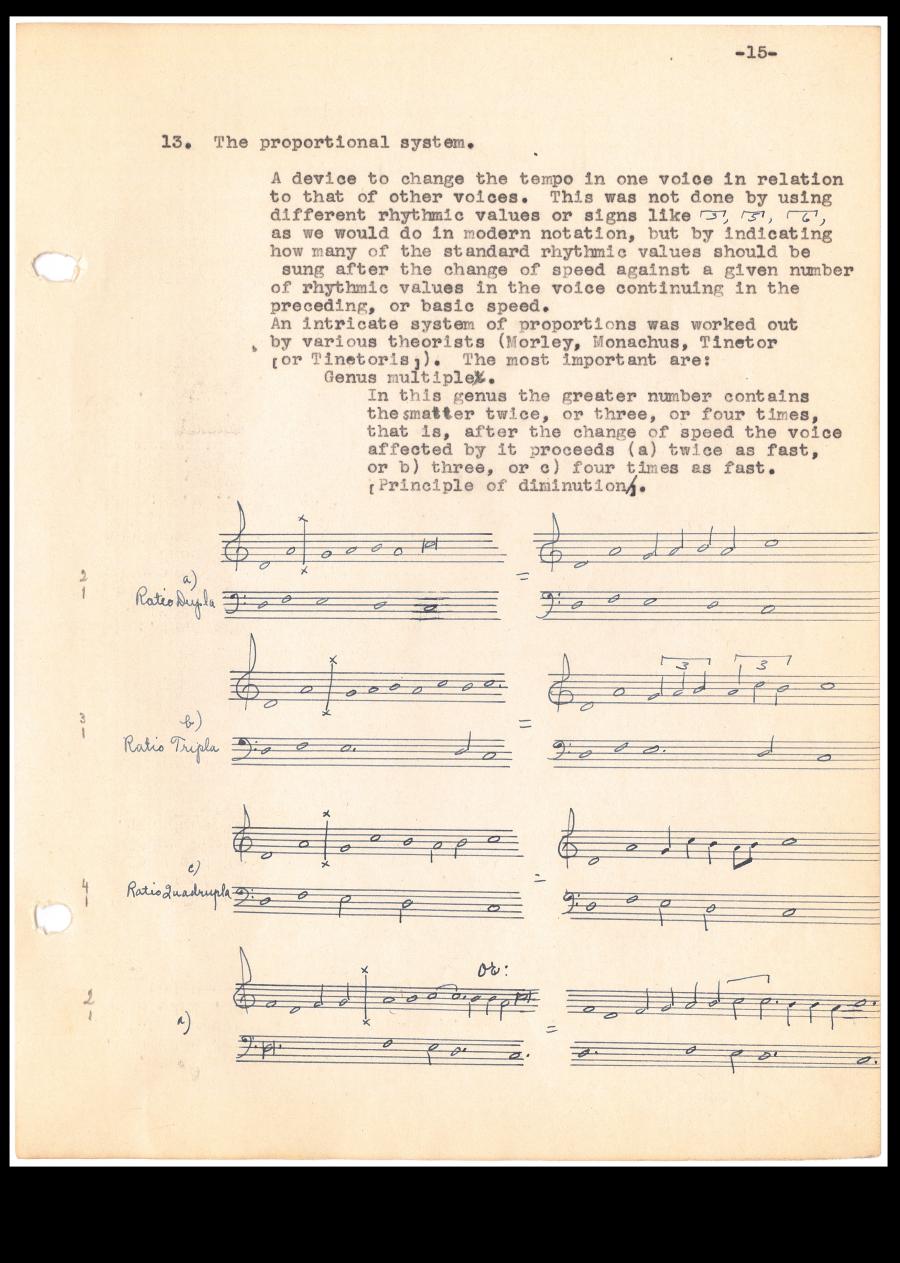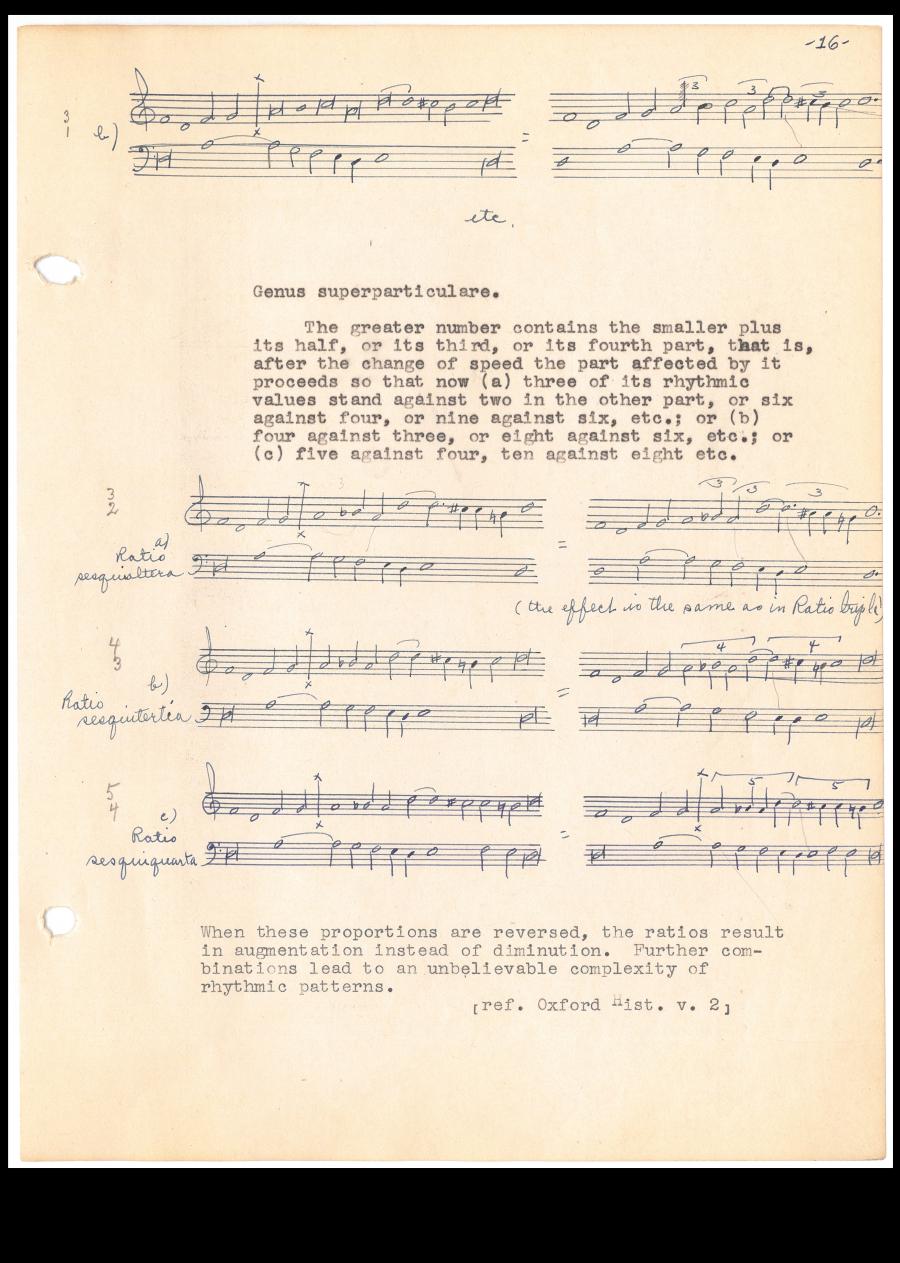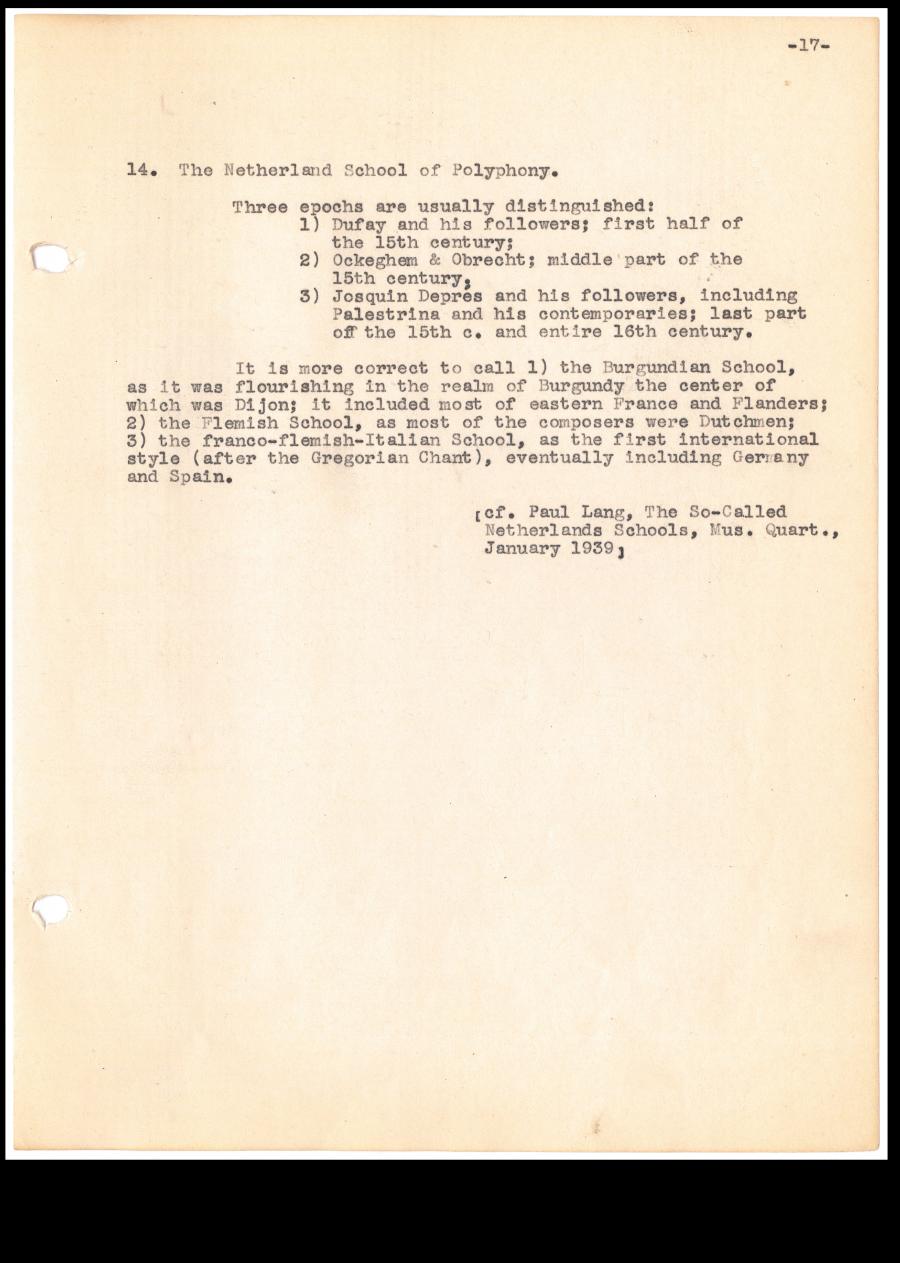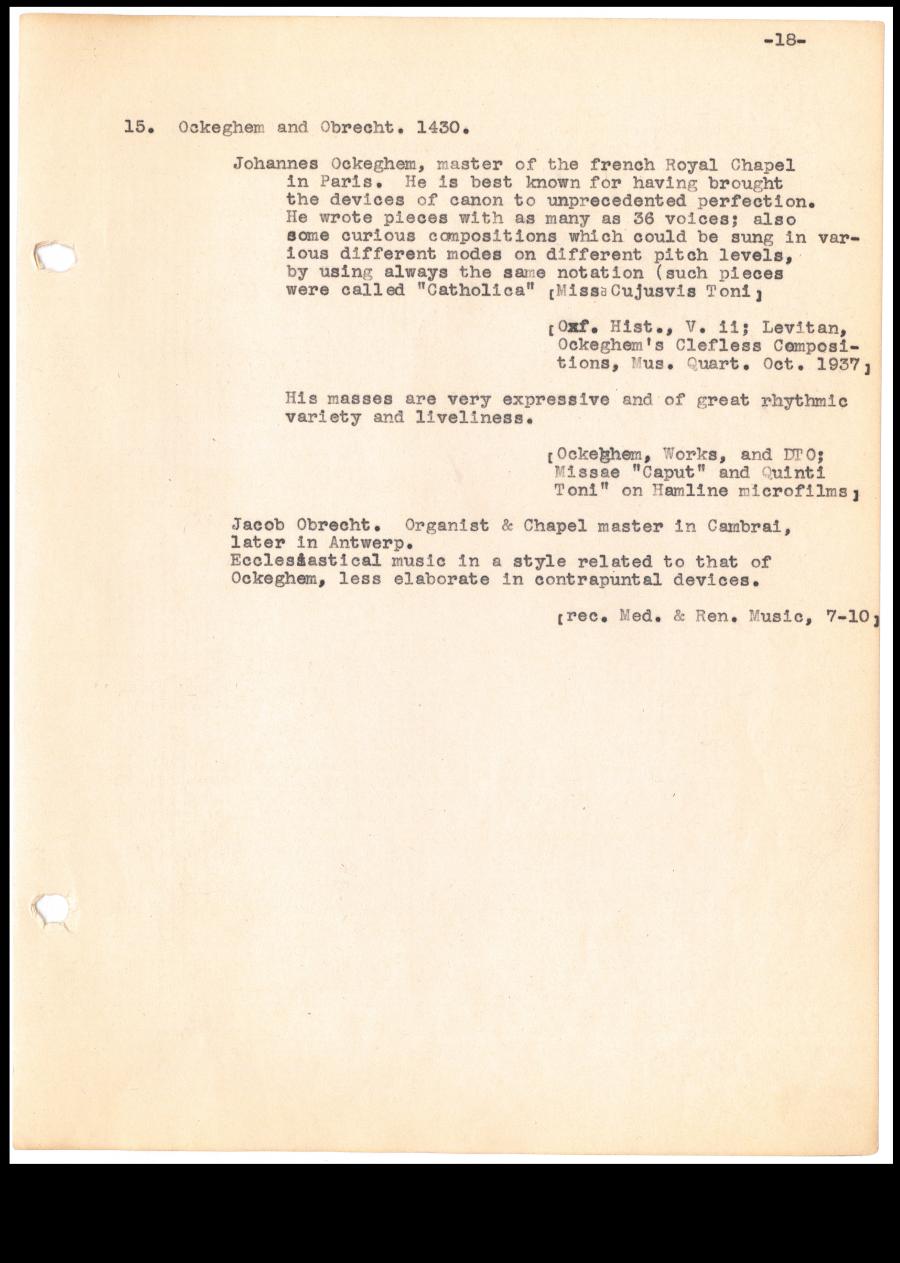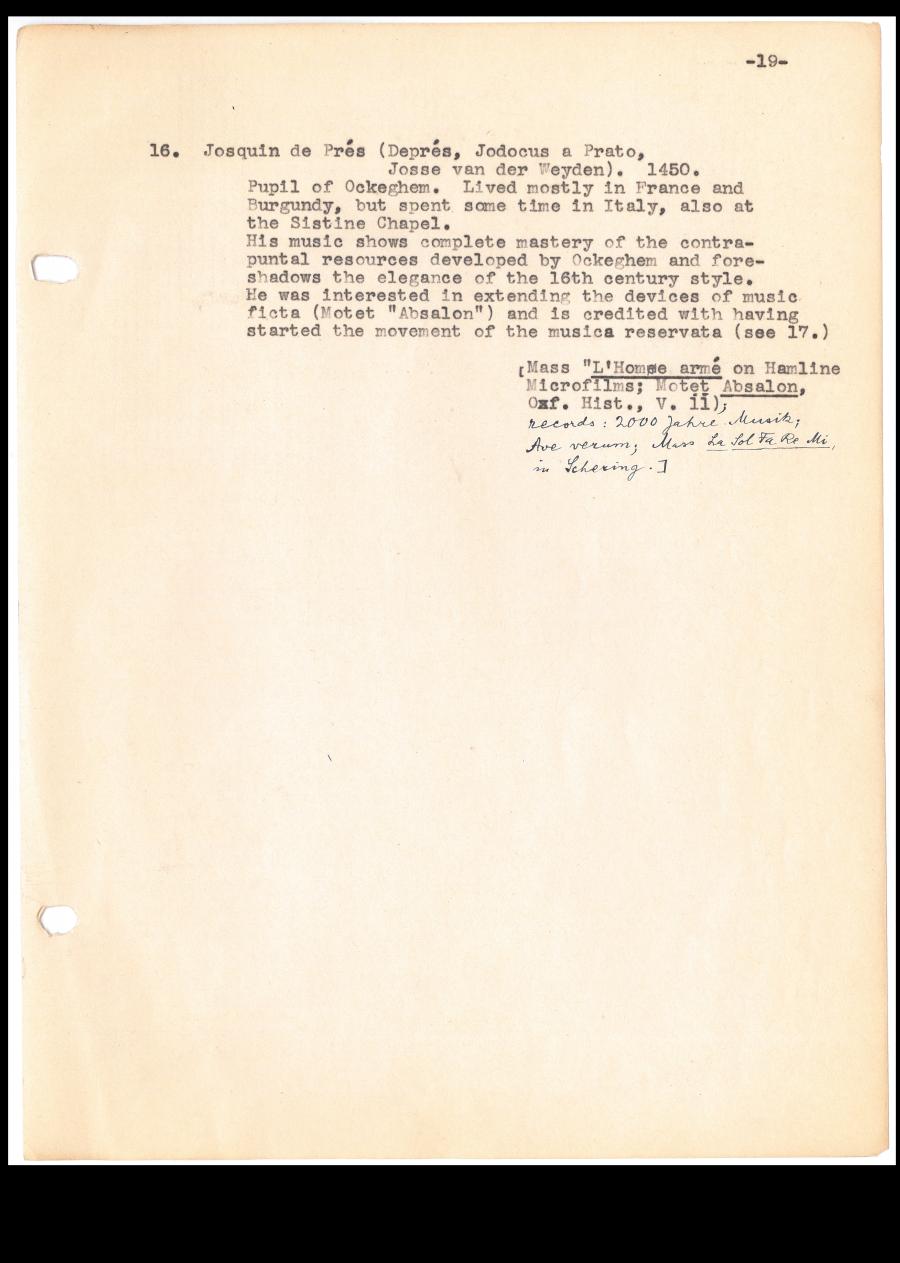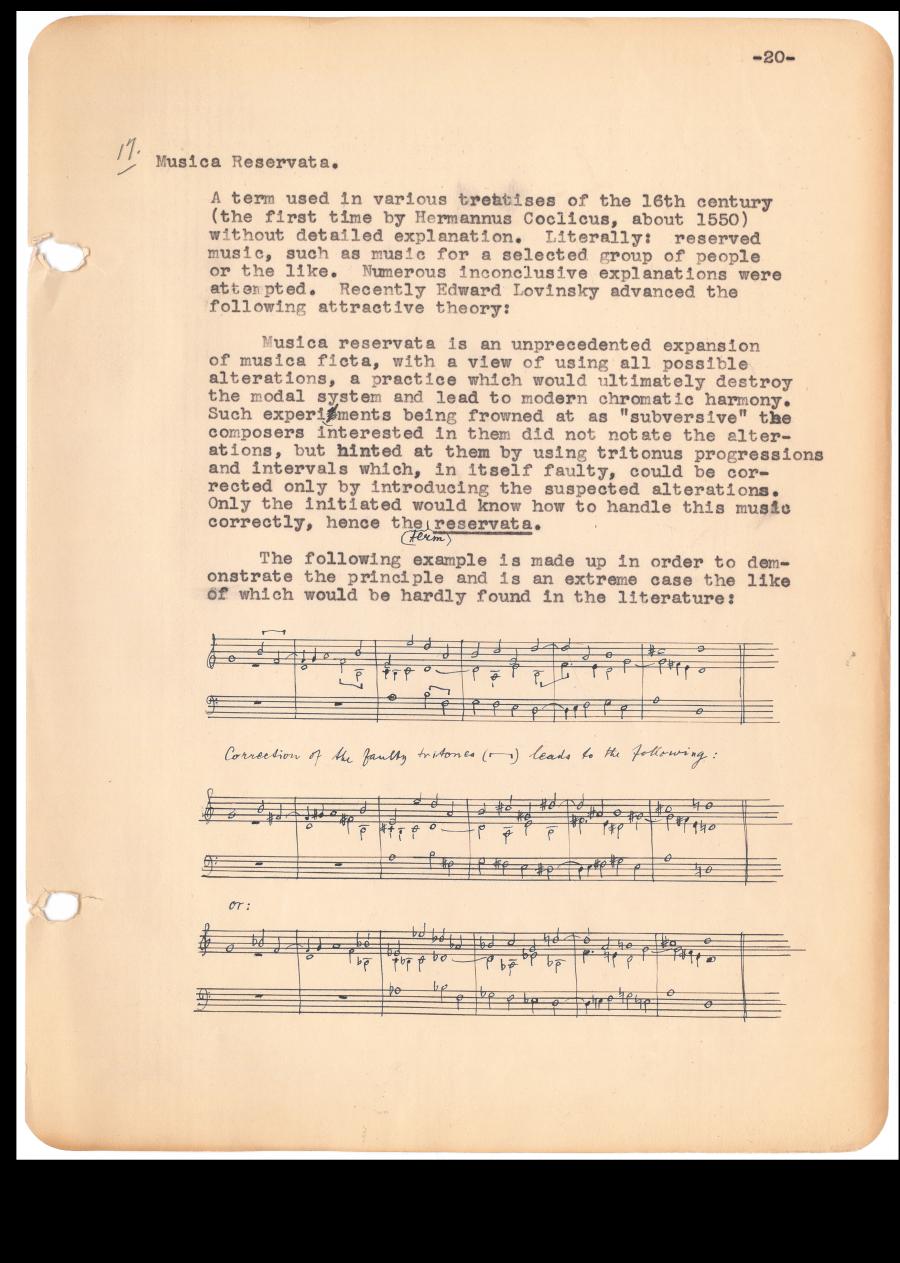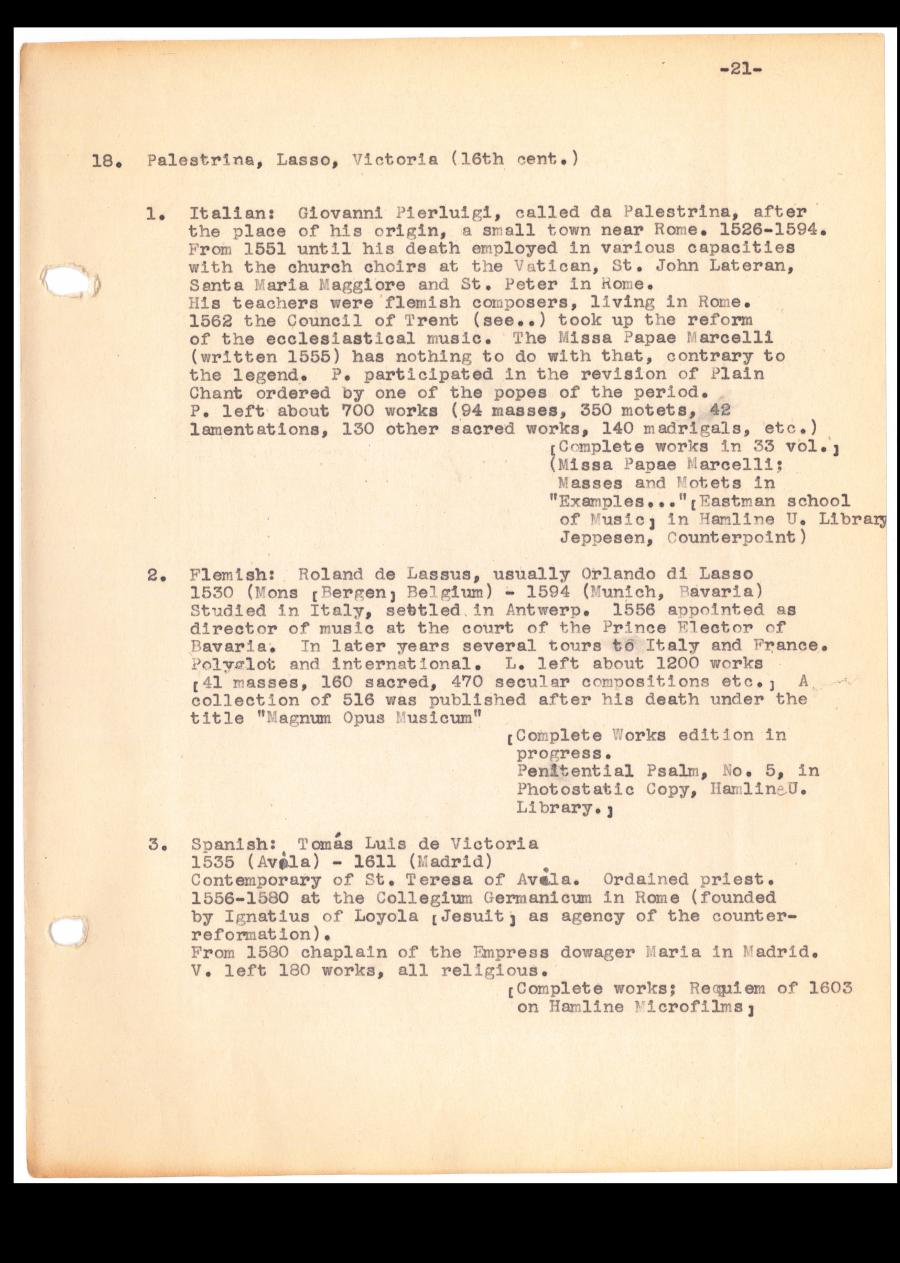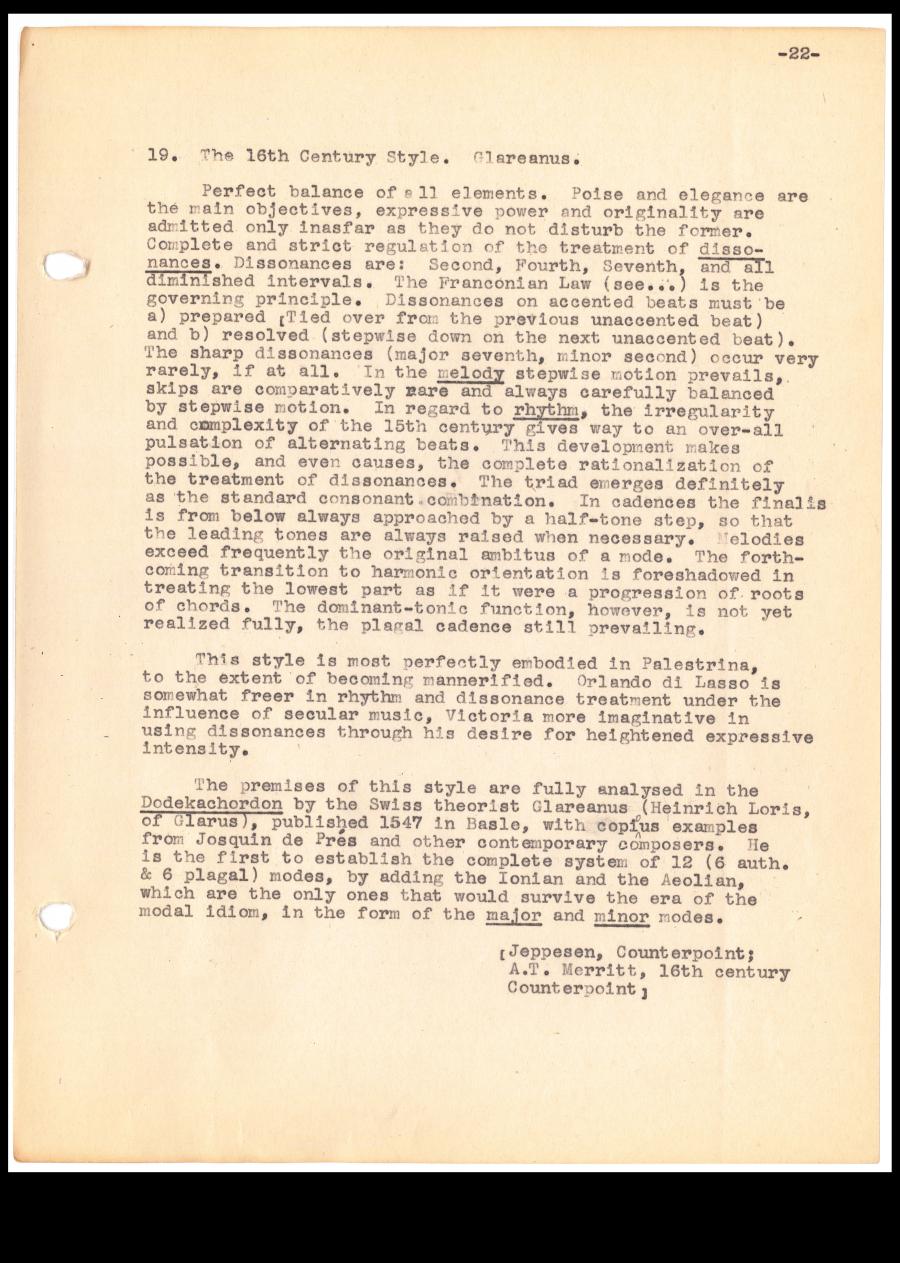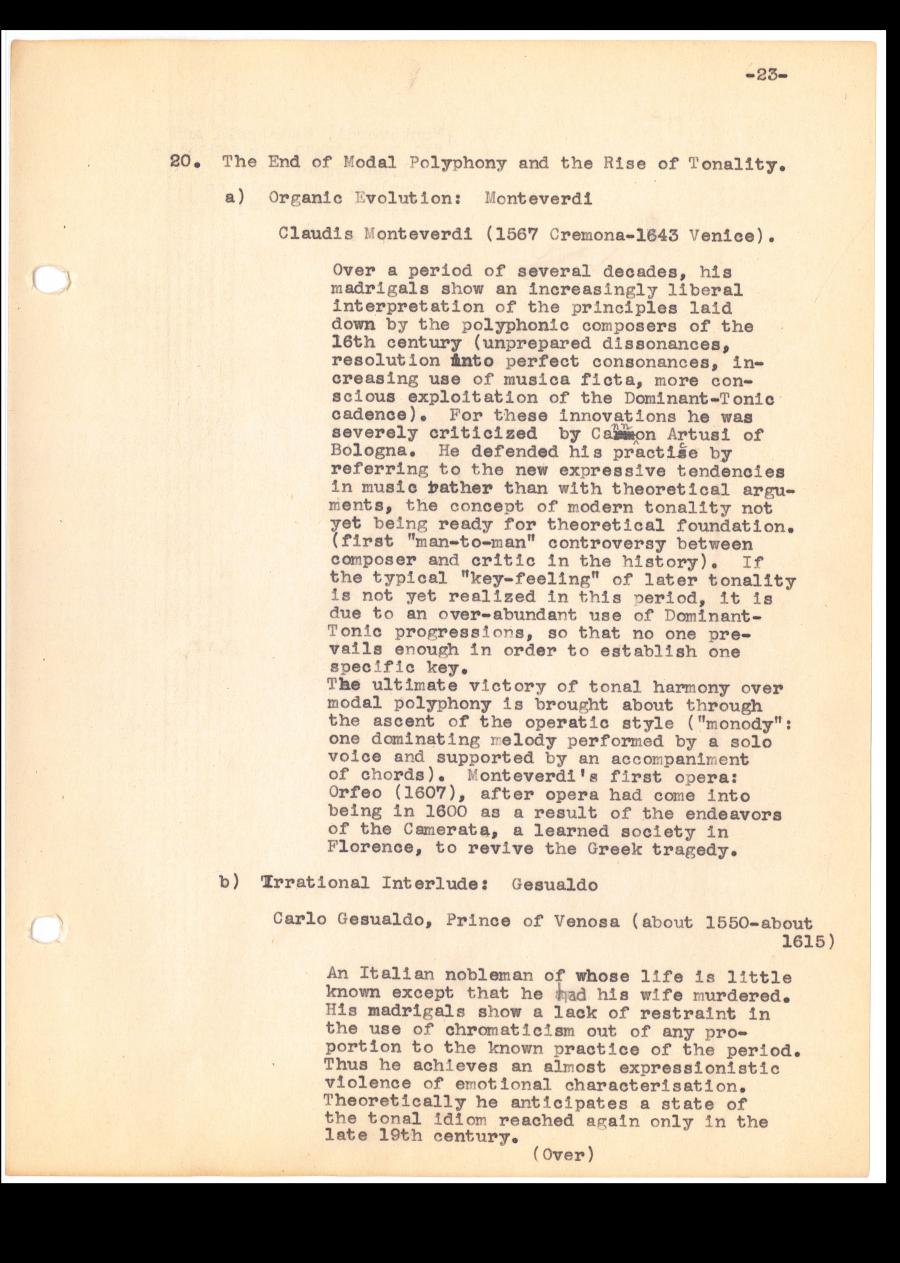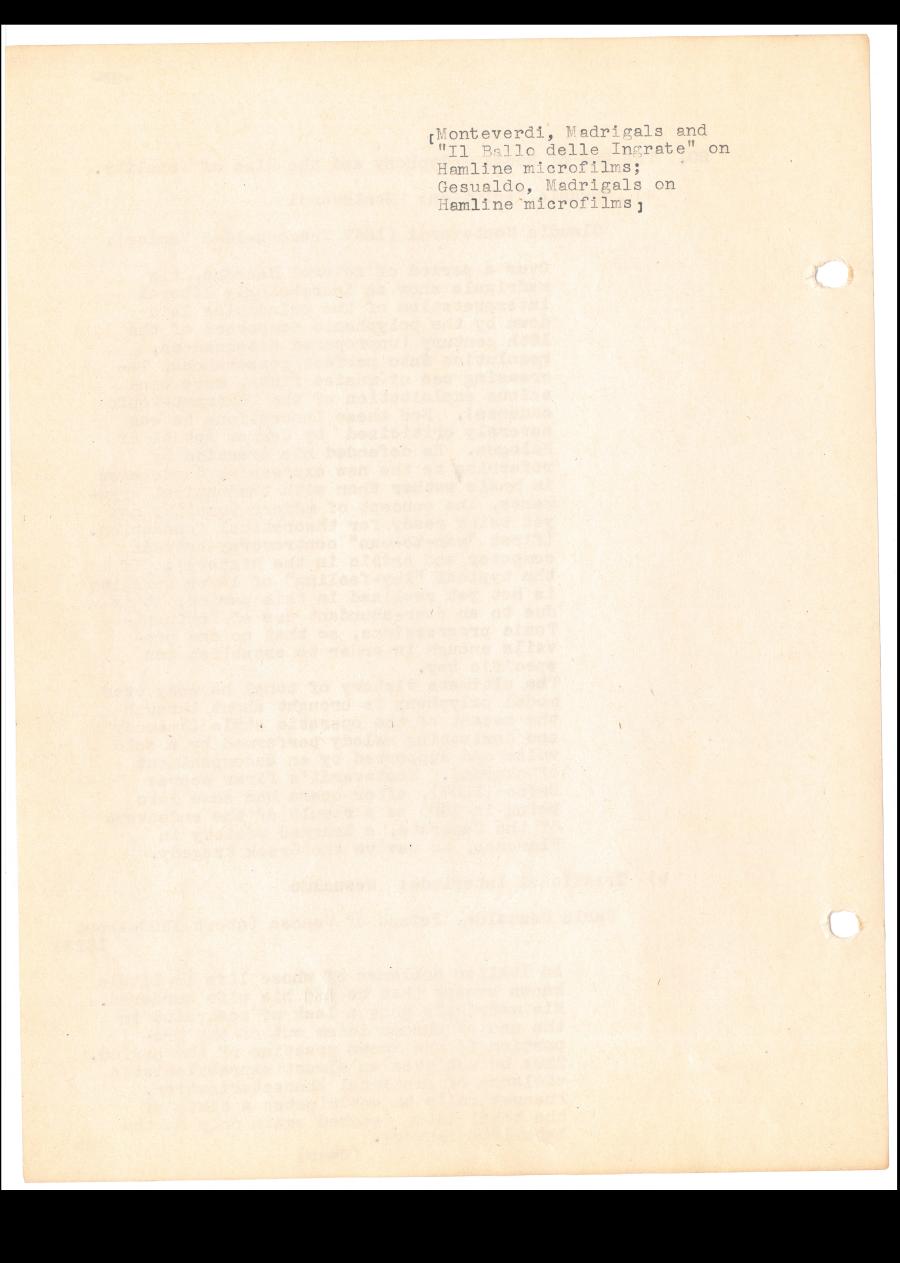Advanced History and Aesthetic Analysis
Abstract
Kreneks Überblick über die Entwicklung west-europäischer Kunstmusik vom Gregorianischen Choral bis zu Monteverdi. Krenek hat diese Unterlagen für seinen Unterricht an der Hamline-University zusammengestellt. Sie zeigen eine gründliche Vorbereitung verweisen auf wissenschaftliche Literatur zu den einzelnen Abschnitten, auf Notenausgaben und Aufnahmen mit besonderen Hinweisen auf Verfügbarkeit in der Bibliothek der Hamline University.
1. The musical system of the ancient Greeks.
Tetrachords:
a) diatonic descending order.
If the "octave species" appearing within the char-
acteristic octave are to be shown as parts of Greater Perfect
Systems, located in each of these Systems at the same place as they
appear in the original System, the result is as follows:
ascending order.
Result: if one calls the cave species "modes", the
modes follow each other in descending order with reference to
the untransposed Greater Perfect System.
If one wants to have all "modes" within the range
of the characteristic octave, one has to assume a sequence of
Greater Perfect Systems in ascending order, corresponding to
the previously established order of the modes.
[ref.
2. Byzantine Chant. The music of the Eastern Church.
Strongly influenced by the music used in the earliest
centuries of the Christian religion, which goes back
to Asiatic sources (
3. Gregorain Chant, Notation, Neumes.
The music of the Western Church, collected and unified
under
The ancient theorist,
Originally psalmody was of indefinite pitch, possibly in the third of the above three manners.
Signs for indicating the desired inflection of the chant were derived from the grammatic accents: acutus ´, gravis `, and circlumflexus ^, which in turn were graphic imitations of the typical gestures of the orator.
This oldest type of notation is called chironomic. Here
the form of the sign indicates the relative position of the tone.
It is later replaced by the diastematic notation (Greek:
diastema - interval). Here the position of the sign indicates the
pitch.
The characteristic symbols of chronomic notation are
accent signs, those of diastematic notation are points.
The transition from the former to the later notation occurs mainly in the 9th century.
In the 10th and 11th century it is replaced by the Guidonian notation, using staves and clefs.
The essential elements of the old neumes are the three accent signs (see above). More signs are derived through combining and modifying these original signs.
-4- Cont'd.
Forms of Gregorian Chant:
1. Strophic:
repetition of melodic and metric patterns
2. Psalmodic:
metrically irregular; alternation of
two melodic patterns, according to
the typical division of the psalm
verses in two sections.
3. Commatic:
free compositions with varying designs.
Manners of rendition:
1. Monologue:
sung by the celebrant
2. Dialogue:
a) responsorial: alternating between
Material of the Chant:
a) Office: service performed at various hours of the
liturgical day. Mostly antiphonal version of
Psalm texts. The melodic formulae used are
called Psalm Tones. Typical form of a psalm one:
jubilus. As it
appeared difficult to memorize these jubili,
the monk
The Guidonian neumes are:
1. ordinary (indicating the basic design of the
melody)
2. liquescent (indicating modifications of the
melody through the text)
3. Romanian letters (only in the
The basic forms of 1. are punctum
Further combinations result in neumes comprising three, four and more tones. That shows that the neumes did not only indi- cate pitches of single notes, but also units of phrasing.
The neumes of class 2 indicate mainly a sort of inter-
mediate short notes (like grace notes) which were inserted when an
accumulation of consonants seemed to call for it.
To this class also belong the quilism, indicating a sort of shake, appearing on passing tones, as a rule.
The Romanian letters (allegedly introduced to the mona-
stery of c - citius, faster, t - trahere, retard,
v - velociter, quickly, etc.)
According to Paléographic musicale, all notes of the
Chant are of equal length (for divergent opinions see
The linguistic accent determines emphases on certain tones.
Apart from that, there is supposed to exist a delicate accent pattern
of "ictus", determined by the phrasing of the rhythmic units expressed
through the neumes. Thus for instance the first note of each group
carries an ictus; so does the note preceding a quilisma, etc. The
beats carrying the ictus are called theses, the other ones arses.
This, however, does not imply dynamic stresses on the theses (as
modern parlance would suggest), unless the linguistic accent co-
incides with a thesis. The Solesmes theory, however, maintains that
such is rather exceptional, the linguistic accent being usually
placed on an arsis, so that a very intricate interplay of linguistic
and neumatic accent patterns is the result.
4. The medieval modes. Identical with the Greek octave
species. The old names were used, but in opposite
order, due to misunderstandings in the translation
of the Greek terms for "octave species" and "Greater
Perfect Systems" (see 1.)
authentic modes belongs one
plagal, or hypo-mode, which has the same final, but an
ambitus from a fourth below to a fifth above the final.
The system as shown here was not fully established until
1550, by the Swiss theorist
5. Early Polyphony.
a) Organum in fifths. 10th century
b) Organum in fourths. 11th century
c) New organum: contrary motion, thirds are used more frequently [record: Medieval and Renaissance music, 2; ref.: Oxford History of Music, v. 1]
d) In the 12th century the organal voice becomes more
and more florid [School of St. Martial, abbey near
tenor (from Latin tenere -
to hold).
6. Solmization and Musica ficta
Any tone in the system could be identified completely by its combination of syllables. The hexachords beginning on F required special treat- ment since a half one step after A was needed. This led to the introduction of B flat. B rotundum, or molle B quadratum, or durum.
The alteration was called "musica ficta" (artificial
music). It was used causa necessitatis (for the sake of
necessity, in order to avoid the tritone), or causa
pulchritudinis (for the sake of beauty, in order to
enhance expressive qualities). Practically only the
B(b)flat was used, but the theorists knew already the
complete twelve-tone scale.
[ref.
7.
Two, three, and four-part compositions (Duplum, Triplum, Quadruplum). Development of organum: the principal voice carries the melody in long sustained notes, the organal voice, or voices, have florid counter- points, usually in rather short phrases of equal length. [record: Med & Ren. Music 2]
Forms of Composition:
Organum (see above)
Conductus (all participating parts are "measured"
see 8.] occasionally interspersed with
Organum)
Motetus (using a cantus firmus from the Gregorian
Chant in the Tenor)
Rondeau (phrases are
8. Cantus mensurabilis (measured music). (13th cent.)
Plain chant (cantus planus) - freely articulated, after the
inflexion of prose. Length of tones not determined. The rise
of polyphony made it necessary to determine the duration of
the single tones. Complicated systems of measurement, accord-
ing to the meters used in poetry. Later three levels of
measurement: Modus, Tempus, Prolatio, Perfect - triple time.
Imperfect: duple time. Example:
After the Guidonian notation had achieved unequivocal designa-
tion of pitches, all further attempts in developing useful systems of
notation have been devoted to clear designation of rhythmic values.
Two main systematical trends: Black Notation and White Notation.
Black notation: the essential devices added to the Guidonian
notes with the purpose of distinguishing various rhythmic values were
stems and dots. The old neumatic groups survived in the ligatures,
groups of notes; if the original meaning of such groupings was to
indicate metric relationships (according to the Solemes (ictus theory),
these groupings were now used to express rhythmie values, according to
the position of notes with or without downward or upward stems within
such ligatures. The systems evolved were not always consistent, very
complicated and variable. Franco of Cologne
White notation: after 1450 the familiar principle of
9. Counterpoint. (13th & 14th cent.)
Regulations in regard to the intervals to be used
between the parts. The most elaborate classification
(Introd. Vol and
10. Ars Nova.
a) greater rhythmic life and variety through introduction of smaller rhythmic values, duple time (prolatio imperfect) and syncopation; b) more extended use of musica ficta in order to comply with the keener discrimination of interval qualities; c) increased attention paid to cadences, through purposeful use of leading tones.
First known polyphonic setting of the Ordinarium Missae: Mass of Tournai (around 1300).
Mus. Quart.]
11. Gamut, Mode and Key.
The diatonic series comprising the medieval modes
is nowadays called "gamut". In some compositions of the
13th and 14th centuries the different voices use
different gamuts simultaneously. This is shown by
accidentals in front of the stave (see
Theoretically a diatonic series can be established
on any of the twelve tones, as it is done in the modern
system of keys.
In medieaeval music the number of available transpositions was limited by the number of available altered tones.
Since originally only the B flat was available, only the gamut with B flat was used besides the original one (shown under 6.) In this gamut the Dorian mode begins on G, the Phrygian on A, etc.
More musica ficta came into being used, when it became customary to raise leading tones in the approaches to the finals from below.
Thus C sharp (in Dorian), F sharp (in Mixolydian) and G sharp (in Aeolian) became available. Besides B flat, E flat was used (as musica fict in the secondary gamut, corresponding to B flat in the original one).
The question whether a transposed gamut can be used, and how far it can be used, is determined by whether the customary musica ficta will not exceed the number of available altered tones.
The following table shows the transformations in-
volved in a transposition of the original gamut to one
with B flat (x marks the customary alterations):
Of the new altered tones, D sharp is not avail- able; therefore the use of the Aeolian mode in this gamut will be restricted, because the leading one of the (transposed) Aeolian mode is D and could not be raised.
A gamut with 2 flats:
D flat and A flat are not available; therefore melodic formations which in the original gamut require E flat and B flat (that is mainly such in the Dorian and Lydian Modes) will be difficult.
The transition from one gamut to another is identical with the modern concept of modulation from key to key.
Definition: Key is the pitch level of a mode.
The medieval idiom has six (twelve) modes, but only a few keys, some of them incomplete (because not all modes can be used in all of the keys.)
The tonal idiom has twelve keys, but only two modes (major and minor).
-14-
12.
Guillaume Dufay, Cannon of Cambrai (france), 1400, 1470.
Masses and Hymns. Use of the Cantus firmus as
a source for the thematic material of the whole
composition. Great rhythmic variety and subtle
distribution of accents and points of emphasis.
Cadence formulae as above, particularly
Most important source for music of the 15th cent:
the Codices of
13. The proportional system.
A device to change the tempo in one voice in relation
to that of other voices. This was not done by using
different rhythmic values or signs like 3, 5, 6,
as we would do in modern notation, but by indicating
how many of the standard rhythmic values should be
sung after the change of speed against a given number
of rhythmic values in the voice continuing in the
preceding, or basic speed.
An intricate system of proportions was worked out
by various theorists (
Genus multiplex.
In this genus the greater number contains
the smaller twice, or three or four times,
that is, after the change of speed the voice
affected by it proceeds (a) twice as fast,
or b) three, or c) four times as fast.
[Principle of diminution/].
Genus superparticulare.
The greater number contains the smaller plus
its half, or its third or its fourth part, that is,
after the change of speed the part affected by it
proceeds so that now (a) three of its rhythmic
values stand against two in the other part, or six
against four, or nine against six, etc.; or (b)
four against three, or eight against six, etc.; or
(c) five against four, ten against eight etc.
14. The Netherland School of Polyphony.
Three epochs are usually distinguished:
1)
It is more correct to call 1) the Burgundian School,
as it was flourishing in the realm of
15.
16.
Pupil of L'Homme arméAbsalonLa Sol Fa Re Mi
A term used in various treatises of the 16th century (the first time by Hermannus Coclicus, about 1550) without detailed explanation. Literally: reserved music, such as music for a selected group of people or the like. Numerous inconclusive explanations were attempted. Recently Edward Lovinsky advanced the following attractive theory:
Musica reservata is an unprecedented expansion
of musica ficta, with a view of using all possible
alterations, a practice which would ultimately destroy
the modal system and lead to modern chromatic harmony.
Such smentsreservata.
The following example is made up in order to dem-
onstrate the principle and is an extreme case the like
of which would be hardly found in the literature:
18.
1. Italian:
2. Flemish:
3. Spanish:
19. The 16th Century Style.
Perfect balance of all elements. Poise and elegance are
the main objectives, expressive power and originality are
admitted only inasfar as they do not disturb the former.
Complete and strict regulation of the treatment of disso-
nances. Dissonances are: Second, Fourth, Seventh, and all
diminished intervals. The Franconian Law (see...) is the
governing principle. Dissonances on accented beats must be
a) prepared (Tied over from the previous unaccented beat)
and b) resolved (stepwise down on the next unaccented beat).
The sharp dissonances (major seventh, minor second) occur very
rarely, if at all. In the melody stepwise motion prevails,
skips are comparatively rare and always carefully balanced
by stepwise motion. In regard to rhythm, the irregularity
and complexity of the 15th century gives way to an over-all
pulsation of alternating beats. This development makes
possible, and even causes, the complete rationalization of
the treatment of dissonances. The triad emerges definitely
as the standard consonant combination. In cadences the finalis
is from below always approached by a half-tone step, so that
the leading tones are always raised when necessary. Melodies
exceed frequently the original ambitus of a mode. The forth-
coming transition to harmonic orientation is foreshadowed in
treating the lowest part as if it were a progression of roots
of chords. The dominant-tonic function, however, is not yet
realized fully, the plagal cadence still prevailing.
This style is most perfectly embodied in
The premises of this style are fully analysed in the
Dodekachordon by the Swiss theorist major and minor modes.
[
20. The End of Modal Polyphony and the Rise of Tonality.
a) Organic Evolution: rms
b) Irrational Interlude:
[
